UCS-Hawthorne-for-Richard-Thaler
Angel Theory V1. Paradigm Shift
Book 4. The TBS ™ Total Business Systems
S-World UCS ™ Hawthorne
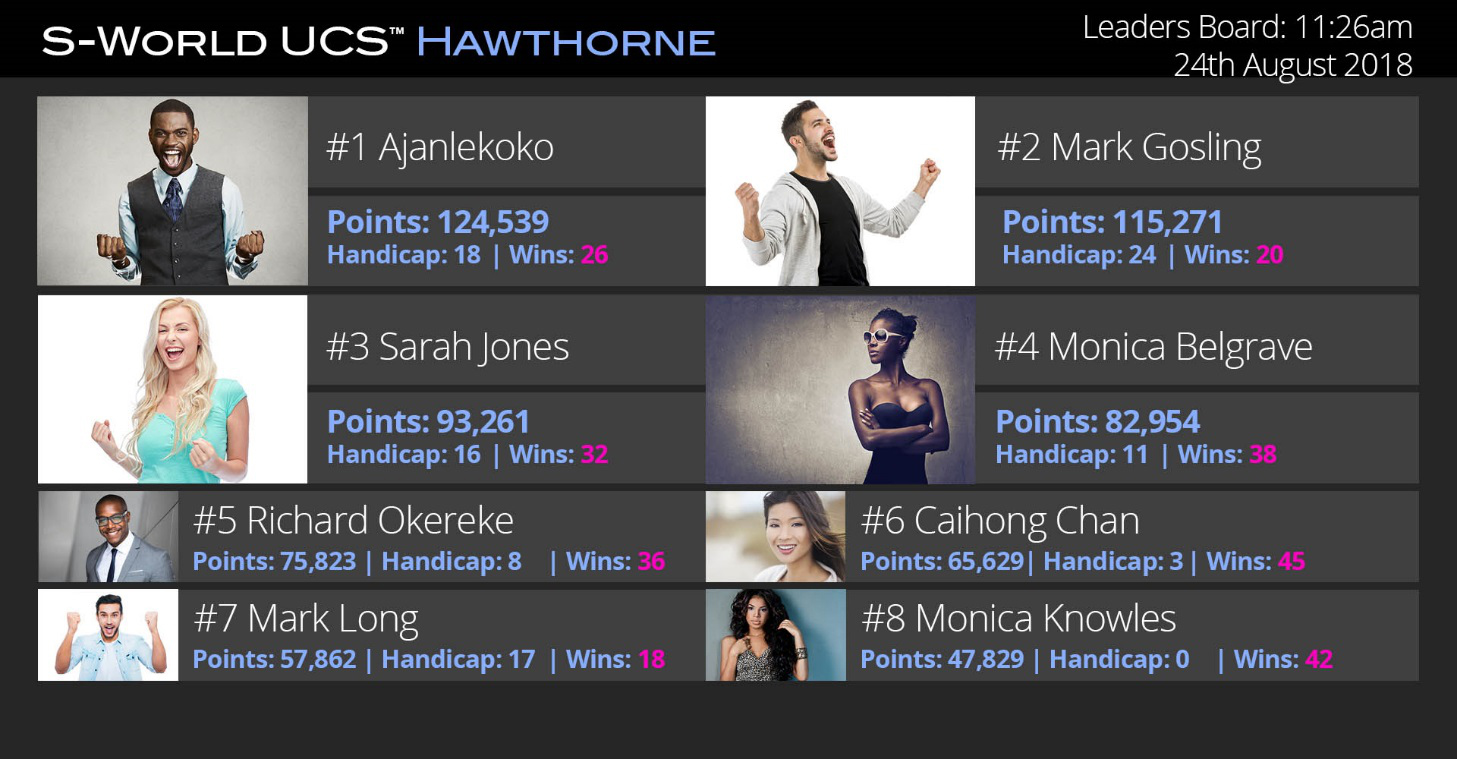
By Nick Ray Ball 14th June 2018
Index
-
Chapter 10. S-World UCS™
- S-World UCS™ Hawthorne
- S-World BES™ ‘Behavioral Economic Systems’
- The Hawthorne Effect
- The Hawthorne Effect for HMRC
- Handicaps
- 5 Important UCS™ Hawthorne Chapters
- UCS Hawthorne – Villa Secrets 2017
- UCS Hawthorne – Villa Secrets 2018
- Financial Reward
- More on S-World UCS™
- The S-World UCS™ M-Systems
- The Quantum M-Systems
In quantum theory, the act of observation led to the famous argument between Albert Einstein and Niels Bohr. Bohr claimed that only the act of observation can cause a particle to give up its wave like properties and materialise in an exact position. This idea was too much for Albert Einstein who disagreed saying, “God does not play dice,” where after Bohr replied, “Stop telling God what to do.”
About 50 years later, after both physicists passed away, Bohr was proved right, only the act of observation can cause a particle to appear. (Albeit this did not affect the two great works Einstein did in his earlier years, both of which are pillars of modern physics. In this example, Einstein was wrong about how electricity and gravity could be unified, which may sound like a small detail, but is in fact ‘the theory of everything.’)
Liking to make systems from analogies or symmetries from theoretical physics, when I found that the act of observation is also a tenant of behavioral economics, I paid it special attention, and this chapter is the result.
Introducing…
S-World BES™ ‘Behavioral Economic Systems’
This chapter opens up a new breed of software based on behavioral science, S-World BES™.
S-World UCS™ Hawthorne is the first software created specifically from an inspiration from behavioral economics.
Unlike all other software designs presented in ‘The Villa Secrets’ Secret’ which all are part of S-World TBS™ ‘Total Business Systems,’ because the Hawthorne Effect is best described as a game, a competition with winners and losers every day, it falls under the S-World UCS™ banner, as S-World UCS is the Gaming, Tutorial, & Simulation Software components to the S-World network.
The Hawthorne Effect
“The Hawthorne effect (also referred to as the observer effect) is a type of reactivity in which individuals modify an aspect of their behaviour in response to their awareness of being observed.”
I was introduced to the Hawthorne Effect via David Hoffeld’s ‘The Science of Selling.’ Unfortunately, I did not take chapter notes so the following is from memory.
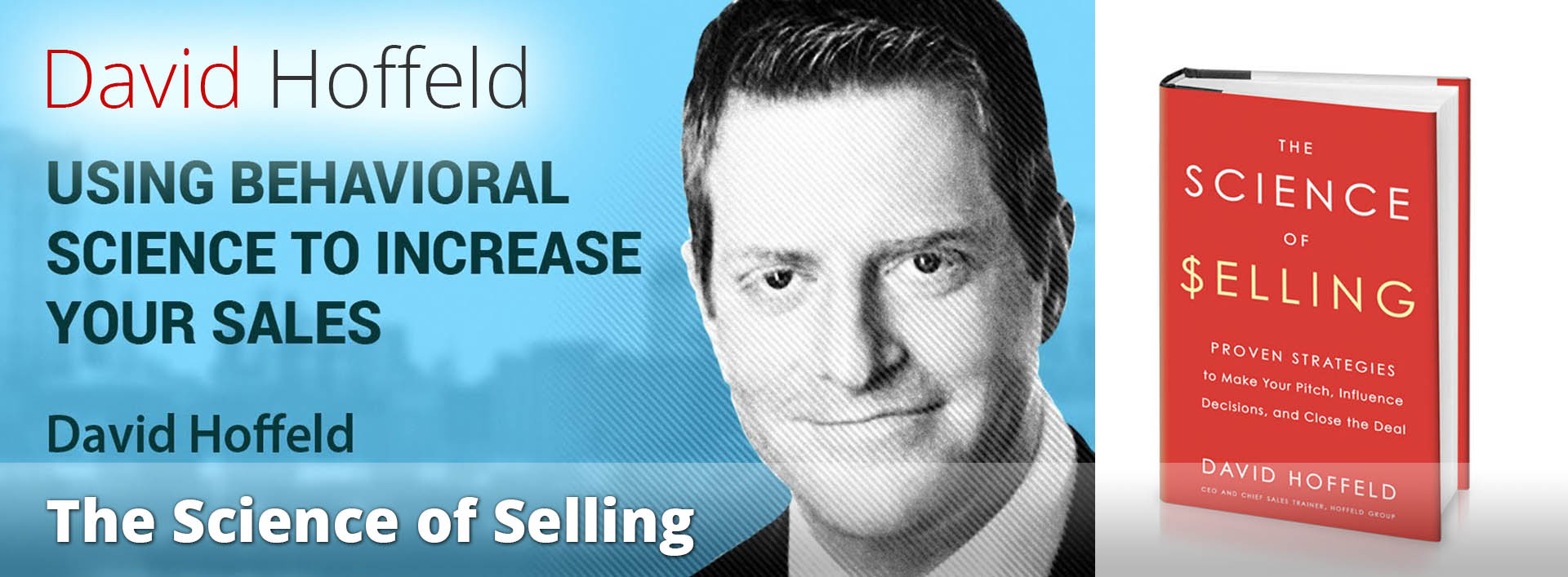
The basics of the experiment described in ‘The Science of Selling’ follows.
A business was split in two; half of the personnel were given a financial motivation and half were not. But when the experiment was completed, all had increased their output.
How could this be? One would expect that the newly incentive half of the personnel would do better; and the other half, who all knew that half of their work colleagues were being incentivised, would do no better and probably worse. But they did not, in fact, all personnel performed better.
The reason why is that both the newly incentivised and the unincentivized both knew they were being monitored and assessed, and that ‘act of observation’ (the monitoring and assessment) increased output throughout all of the office.
This is not to say a financial incentive is not a good motivator, 4 billion people working for money is hard to argue with. But what it does show is that if one can create a constant ‘observation,’ then that observation alone is enough to increase the performance of the whole team.
The Hawthorne Effect for HMRC
To begin, simply, following on from Chapter 7. S-World TFS ‘Total Financial System,’ which features HMRC (the UK Tax Collection Agency).
Because a pure Hawthorne Effect (an effect created without financial incentivization) can be illustrated well for HMRC, the first demonstration of S-World UCS™ Hawthorne will be framed within the new suggested HMRC framework.
After the HMRC example, we shall have a brief tour of the other S-World systems needed to make UCS™ Hawthorne work before presenting the Villa Secrets example. And lastly, leaving with 2 S-World UCS™ excerpts from Angel Theory – Paradigm Shift.
We shall start with another look at the scoreboard that introduced the chapter… And note that the staff and dress codes have been created for Villa Secrets personnel not HMRC.

So, what are we looking at here?
We are looking at a daily competition between a team of 8 HMRC customer service agents, in which each customer is tracked through the support process. If #8 Monica Knowles (who is actually the best rep in the team, as told by her handicap of zero) speaks to a client and guides them all the way to completing the tax return, Monica gets points; and the greater the value of the return, the more points she wins. A customer satisfaction survey simply asking to rate the agent from 1 to 10 can also be added to increase or decrease points per customer. But the main points are won by successfully seeing clients through the process as quickly as possible.
Handicaps
Monica has won the day 42 times this year and has a handicap of zero. Handicaps are needed to enable the weakest or maybe just the newest members of the team to be able to compete and win. Let’s consider the current 2nd placer Mark Gosling. Mark has 20 wins under his belt. But the wins would not be wins if not for his handicap, based on golf, but changed simply to an amount of points given at the start of the day. For example, at 9 am when the day’s game begins, Mark would start with 75,000 points; whereas Monica, with a handicap of zero, starts at zero. And Richard, with a handicap of 8, would start at about 30,000.
As the day goes through, the low handicap players will (on average) collect more points and by the end of the day will win or be there or there about; unless they have a bad day or just bad luck, which happens. In this example, Mark Long is having a bad day.
I would suggest that once the game has been played on enough days, then the two lowest handicap players spend 2 hours a day assisting the high handicap players; mentoring them and helping them to assist the clients who are giving them few or even negative points.
Even if the low handicap players are not keen, or are no good at teaching, that’s ok. They can just deal with the hard enquires and clear the backlog for the higher handicapped agent, who can just watch and learn. During these 2 hours, points count double, each point gained counts for both the low handicapped assisting agent and the high handicapped assisted agent.
Work Flow
As soon as a new HMRC client (identified by their ID) contacts the support team, the first person who speaks to them becomes tagged to their future journey. If the client is assisted and later recontacts HMRC about another matter (a different deal stage), then no problem. But if the client recontacts HMRC about the same problem, then the initial responder would lose points.
All of this will be made possible by adaptations of the S-World CRM-Nudge Ai and the CRM CC Company Controller which would be accessed via desktop computers’ and mobile apps.
Below, we see a mock-up of the CRM-Nudge-Ai’s tasks list, and a point score of 25,000 points is awarded to the agent once they have guided a particular client (in this case, myself, Nick Ray Ball) through the very tricky minefield of the corporation tax form.
Note that in Chapter 7, we recommend a breakdown of the complexities at HMRC and suggest a far simpler system with very detailed tutorials, written and on video. But let’s not worry about that here, rather focus on the game, and that an agent has just won 25,000 points.

Why would a team leader want to help the lowest players? If by doing so, they are in effect teaching their competitors to win?
I can’t say how many customer service agents HMRC have. So, for now, I will guess at a convenient figure of 64.
Below, we see a different screenshot in a similar format. But this time, we see 8 different teams, each represented by each team’s lowest handicap player. In the example we just saw, as Monica Knowles has the lowest handicap, and so the team is named ‘Team Knowles.’
We see Monica’s ‘Team Knowles’ in position 3 with a combined handicap of 257, with Team Nash in the lead with a combined handicap of 179, and in last place is Team Goodbun with a combined handicap of 316. Note that one can have more points than another team as seen in team 4 vs team 3, but the combined handicap is the stat that counts.
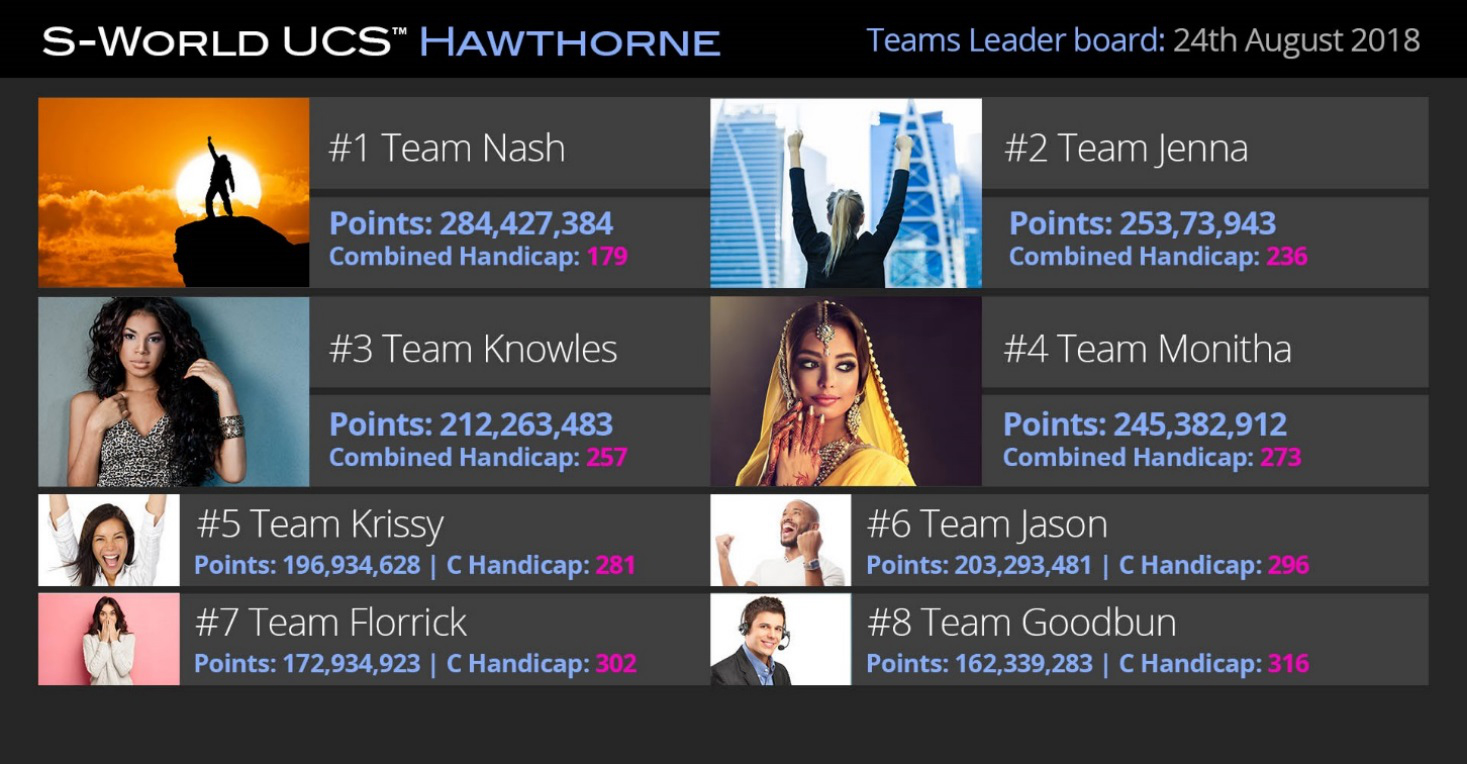
At the end of a cycle, maybe a year or maybe per season, a shake-up may happen. Let’s say in Team Nash (1st) both the 1st and 2nd placed agent has scratch handicaps (handicaps of zero). But in Team Goodbun, the first and second placed agent have higher handicaps. In this case, the second placed handicap agent in Team Nash would swop for the lowest scoring agent in team Goodbun (8th).
Whilst in this game points winners do not receive cash, you can be sure that advancement within the department would be linked to both low handicaps and teaching, which pretty much eliminates the need for management. And maybe the money allocated for such managers can be used to further incentivise the low handicap players, to both teach their teams better and to work outside of the office.
The Hawthorne Effect
Creating this game between the agents means all agents and all teams are in a permanent state of observation, as they are all observing each other. And management and the bosses all pay attention to the stats gleamed from the game.
In the example given from David Hoffeld, the observation effect is more powerful than financial incentive, albeit this stat is surely overturned if we were taking about a lot of money. If we are talking about winning a week’s salary each day, then that’s a pretty big motivator.
So far, we have considered this as a laptop and mobile experience. Now, consider this:
Place large screen TV monitors on the walls at the offices, display the results of all the games clearly for all to see, and add some gongs and the big bell rings when particularly tricky deals are won.
This is UCS™ Hawthorne; ‘everyone is observing everyone else, every minute of every day.’
Before we get into the more advanced Villa Secrets model, which introduces significant financial incentives to winning the game (win the day), we will take a quick look at five important components that help make S-World UCS Hawthorne possible.
5 Important S-World UCS ™ Hawthorne Chapters
-
-
Chapter 1
- S-Web CMS Software and Web Development Framework
- Network.villasecrets.com/the-secret/ch1/s-web-cms-framework-step-6-our-solution
-
Chapter 6
- S-World CRM-Nudge-Ai
- Network.villasecrets.com/the-secret/ch6/crm-nudge-ai
-
Chapter 7
- S-World TFS ‘Total Financial Systems’
- Network.villasecrets.com/the-secret/ch7/tfs-total-financial-system
-
Chapter 9
- S-World CRM-CC ‘Company Controller’
- http://network.villasecrets.com/the-secret/ch9/crm-cc-the-company-controller
-
Chapter 14
-
S-World TBS ‘Total Business Systems’
The dedicated chapter for the TBS™ is not currently online, but a good introduction to it is presented in Chapter 1. - Network.villasecrets.com/the-secret/ch1/s-web-cms-framework-step-6-our-solution#s-world-TBS-total-business-systems
-
Chapter 1. The S-Web CMS Framework

S-Web CMS Software and Web Development Framework
S-Web is a web and software framework in which all web and software systems are part of the same framework. So, for instance, where one usually buys or licences CRMs (Customer Relationship Software), which needs to be connected to your website via a complex API, if one wishes the data to come straight from the website and online forms to the CRM. The S-Web CRM and website are the same thing, so no one needs to perform complex API development.
The more software one buys from different companies, the more complex it gets. You only need a few systems from a few different developers, and the law of limiting returns on what you can achieve from your system is severe.
Have a look at the following 2 graphics.
Below, we see the complexity of connecting a website to three different systems: a financial system, a CRM, and inventory connections.
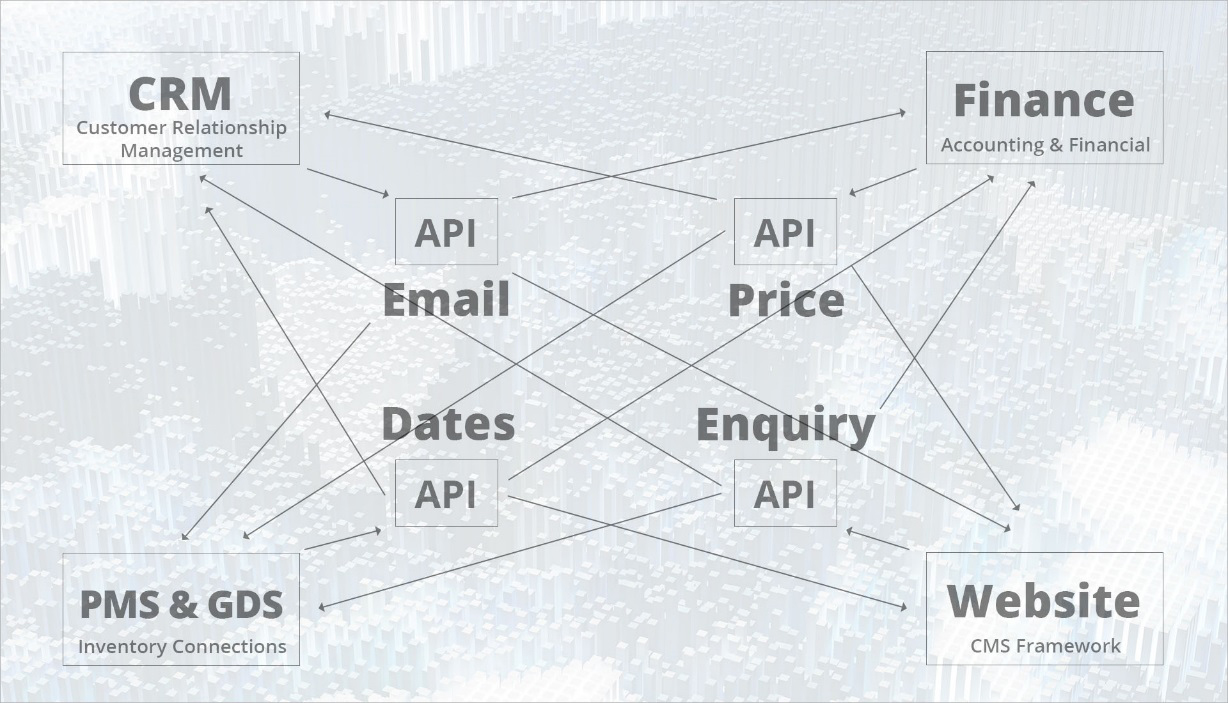
Now, look at the S-Web Framework; in this example, accessing a price from the database. And as each part of the framework is just one hop away from the database of common items, access is easy.
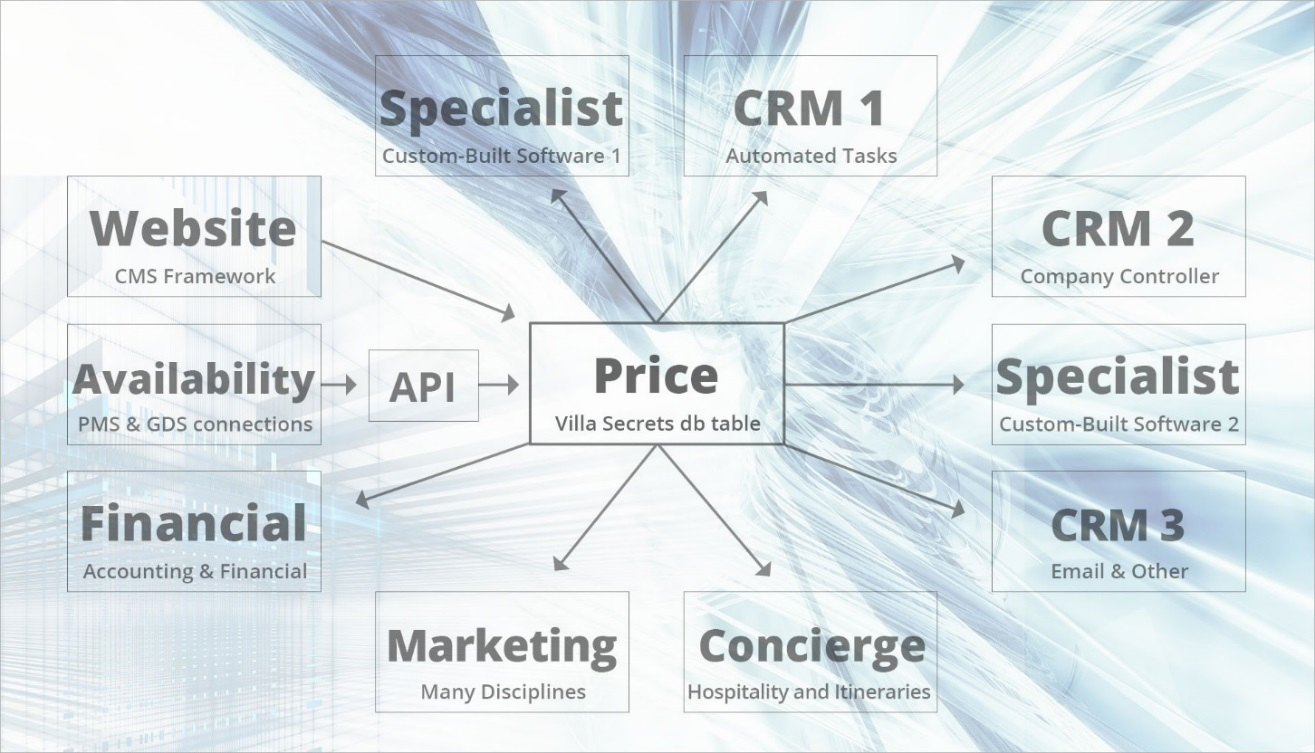
In short, whilst it’s not completely impossible, it’s extremely hard to create the type of software that is described in S-World Villa Secrets, if one is using different systems from different developers pieced together.
Chapter 6. The S-World CRM-Nudge-Ai

Chapter 6. The S-World CRM-Nudge-Ai
The S-World CRM-Nudge-Ai is a design for an integrated CRM that pays careful attention to behavioral economics to sometimes steer and sometimes nudge agents in the right direction.
Created mobile first so agents have no need to be in the office and can continue working into the evening and at weekends. The Ai is a special feature which will become a system that, for the best part, can answer client’s enquires, ask questions, and present more options in real time. Then, as bespoke villas (properties not on inventory databases) return emails to say their property is or is not available, the new properties available are presented live as they come in. Where after, the client can start to negotiate with this and that villa owner.
By the time the human agents enter the conversation (assuming they were busy the time of enquiry), the deal could be well advanced and need only some finishing touches. And for the most part, the client would have had no idea that from the beginning (or sometimes the entire) of their customer journey that they were talking with an Ai. And further, that in the future, the Ai may well become a better agent than any human, and agents are removed from the process altogether to be replaced with concierge reps.
The Ai speeds up response time dramatically and can assist an agent to perform 2, maybe 3 times the amount of work they would be able to do without the system; and it teaches agents how to improve at sales via behavioral economics. For instance, ‘how many villas should an agent send?’ Well, Hoffeld’s ‘The Science of Selling’ suggests two is good. But after the 2 villas are sent, send a 3rd, which is not as good as 1 or 2, as this reinforces the client’s current first pick choice, as now in place of best of two, it’s the best of 3. Which makes sense to me, but experience also makes sense to send more like 10 in a technique I call ‘flushing out the completion.’ The logic being to send as ‘also-rans’ all the villas that a competitor would likely send but prioritise one or two.
The CRM-Nudge-Ai will first send just two options. But if the client does not reply or go on to the website, another 15 minutes later, a larger selection will be sent. And we will, of course, see over time what works best and look for idiosyncrasies such as different cultures having different preferences.
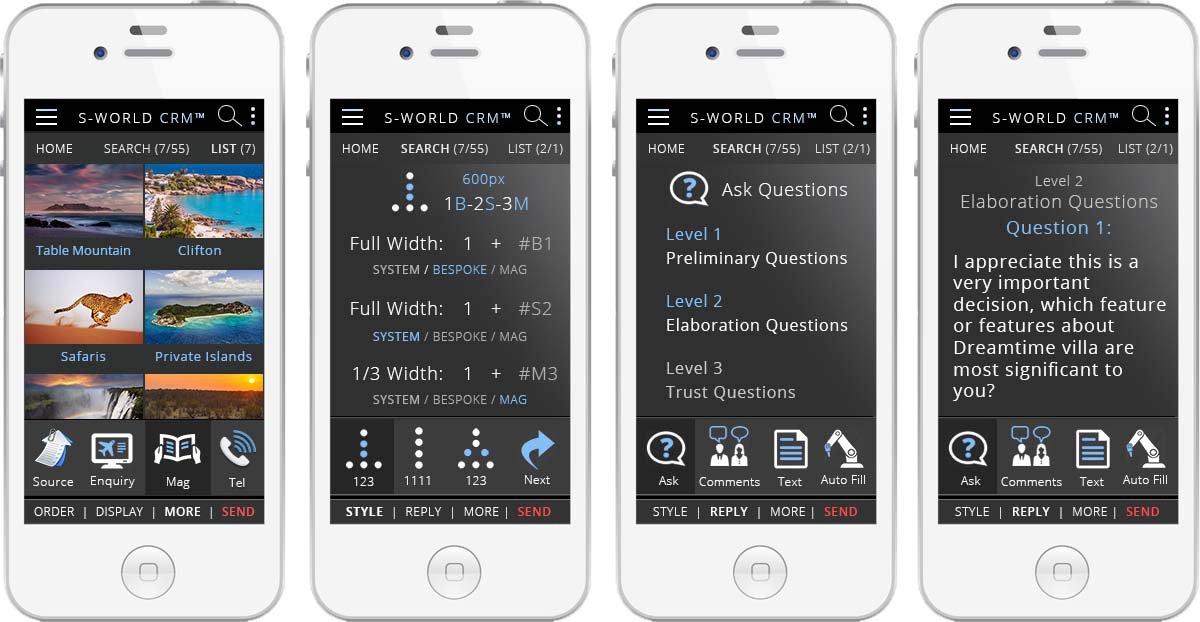
Note that this system is part built on S-World CDS ‘Content Delivery System’ technology, see Chapter 4. S-World CDS™.
Lastly, we look at the way we wish the Ai to work with the teams in the creation of a continual feedback loop.
The CRM-Nudge-Ai, assisted by a behavioural insights team, suggests the best path. But out in the real world, some things work, and some things don’t, and they call it experience. So, agents are (to a degree) given a free reign to experiment and do things that are ‘off script.’ And if this works out, we write it into the system for others to try. And if the new ‘idea’ works more often than not, it becomes a part of the Ai, and round and round it goes, always learning.
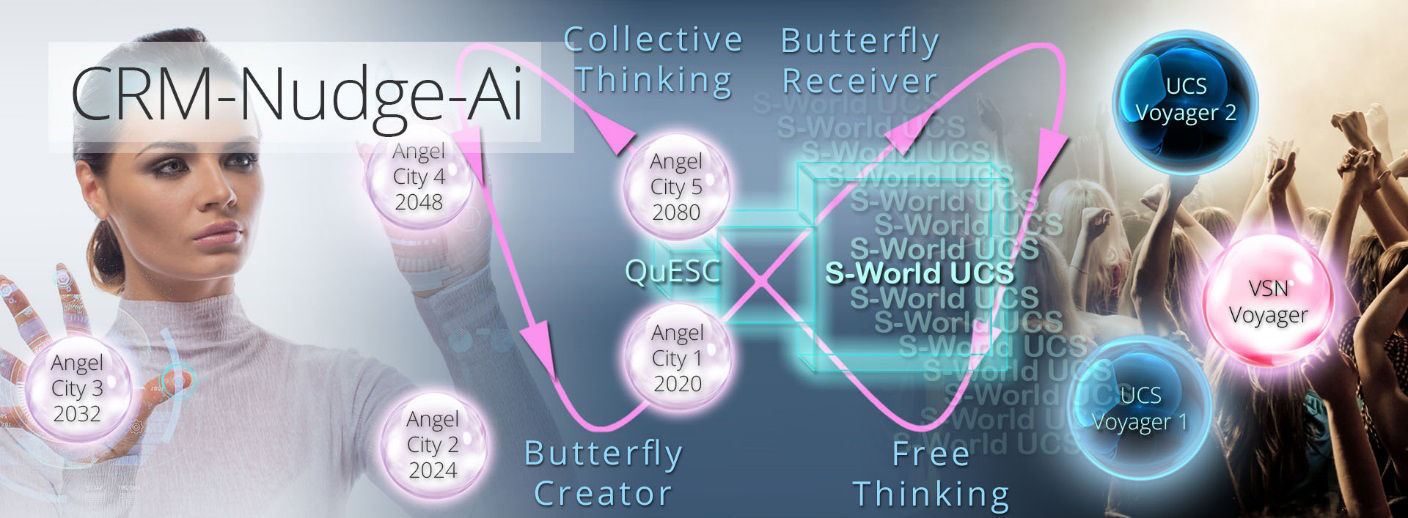
Chapter 7. The TFS™ – Total Financial System
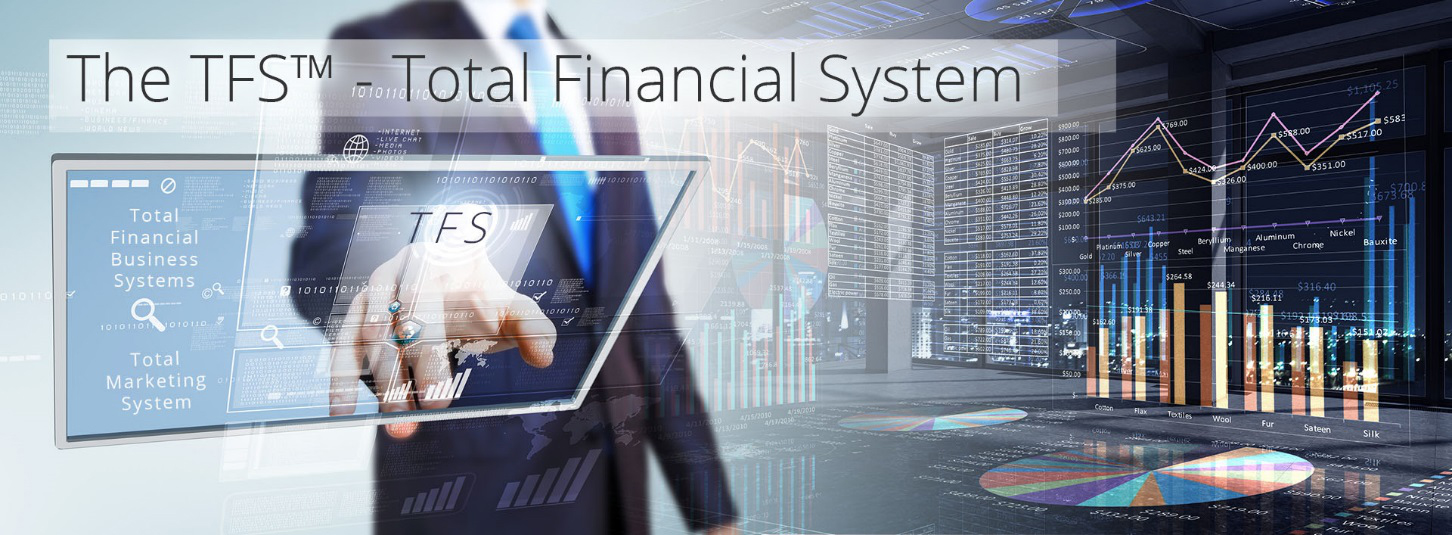
S-World TFS ‘Total Financial Systems’
Whilst the UCS™ Hawthorne does not need the complete financial integration that the Villa Secrets design would desire, financial integration would be useful, as then one can immediately award points as soon as a client has made their payment, and that points can be relative to the amount that was paid.
We find a detailed critique of HMRC with solutions within this chapter at the following link:
Network.villasecrets.com/the-secret/ch7/tfs-total-financial-system#4-barriers-to-entry
When it comes to UCS™ Hawthorne for Villa Secrets, bank integration or access to banking data really does become very useful. For example, every booking made creates points score for the agent that made the booking and all involved in getting the villa online in the first place; from the photographer to the property manager, all get a few residual points each time a villa they helped with goes online.
Chapter 8. S-World CRM CC™ – Company Controller
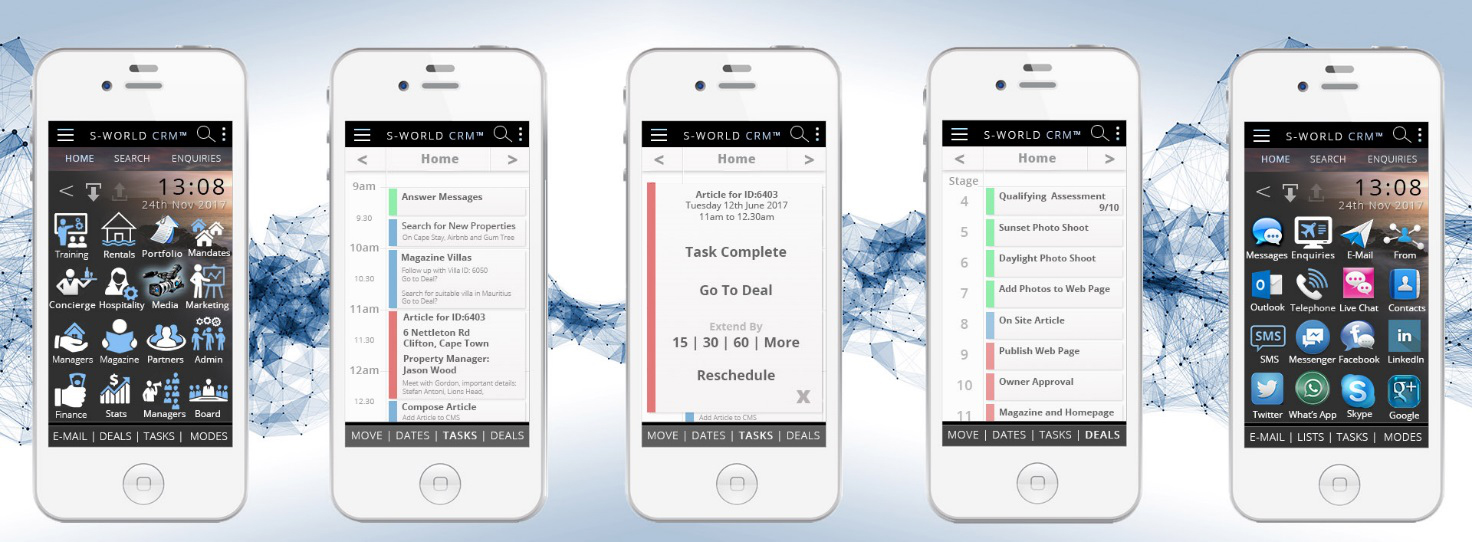
S-World CRM-CC ‘Company Controller’
The property of the CRM CC™ that is essential to the UCS™ Hawthorne process is the creation of task lists, and it does so by assigning no more than 50% of ‘must complete’ tasks, such as a meeting with a client. Where after, the rest of the tasks are tasks that can be postponed without affecting the smooth running of the business.
This kind of set up is essential for users of the software to be able to extend meetings or spend more time on a specific urgent enquiry or other task. We can see this in the example below. At the end of the allotted time, the option to extend appears. And if extended, the ‘non-priority tasks’ (in blue) all move forwards.
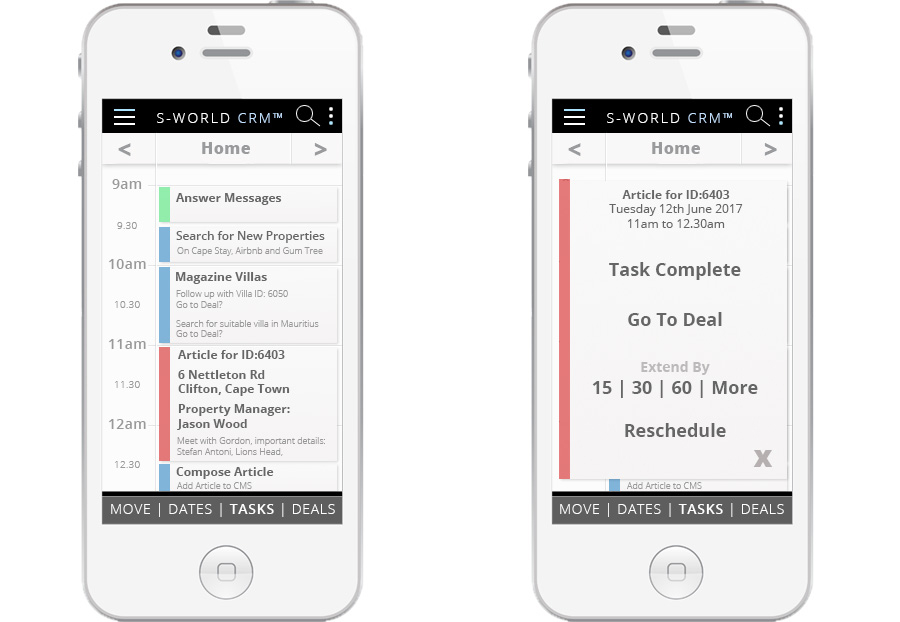
Below, we see the ‘deal path’ for recruiting a mandate (see Chapter 3), which is the most important task. Currently, there are over 11 different deal stages to be performed by different members of the team overseen not by a manager but by the software.

Chapter 14. S-World TBS™ – Total Business Systems
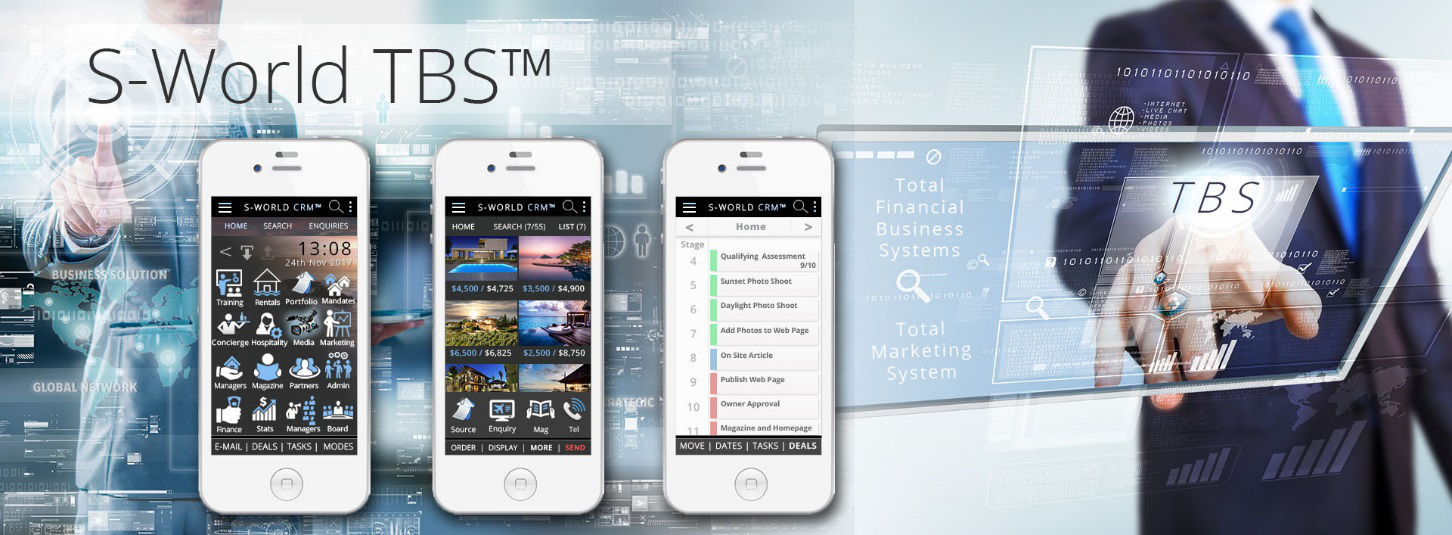
All of the systems presented thus far and others including marketing and SEO are subsets of the ‘TBS™’ Total Business Software, Book 4 in the Angel Theory – Paradigm Shift range. I will demonstrate this system with the summary from Angel Theory – Paradigm Shift. Or see The TBS™ described on The Villa Secrets’ Secret.
Book 4. The S-World TBS ™
Part 1. Total Business Systems
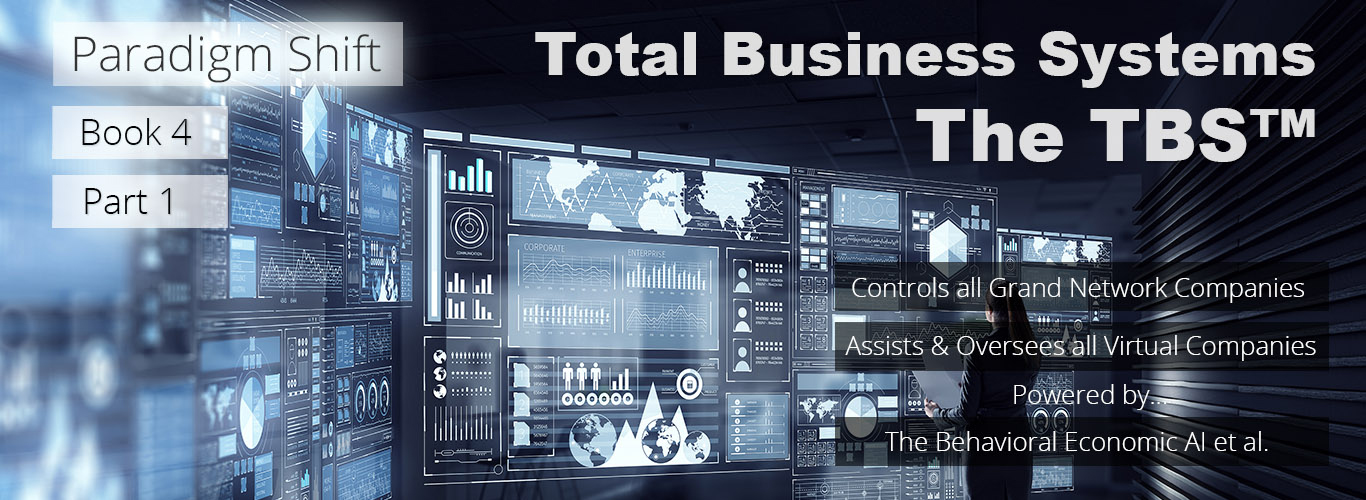
Attempting a project like this without a system like the S-World TBS™ would be futile.
The S-World TBS™ is the software needed to run a global network, originally described for VIRGIN on 18th March 2011. It is M-System 1 and its functionality has been written within its own book ‘The Villa Secrets’ Secret.’ A summary of this book is found here: Network.villasecrets.com.
The TBS™ design is made of many components, from the Company Controller to the TFS™ (Total Financial System) to S-Web™, which creates extremely complex and sexy websites in record time. One critical part of its design is that all components from the website to the CRM to the accounting are created as one system, there can be no hopping from one item of software to another, as this is a chaotic way of programming, and has extreme laws of diminishing returns relative to its complexity.

This project is already in development, and already has a number of unique components that either make money, save money, or avoid landmines.
Digging further, we see that in place of the CRM software such as Salesforce which creates software for all business types, the TBS™ is to be created one industry niche at a time; this greatly simplifies the software and makes it much more user-friendly.
This niche by niche production system allows one to specialise in specifics; for instance, by asking 2017 Nobel Laureate Richard H. Thaler to plough his knowledge from behavioural economics into the various AIs, one case at a time.
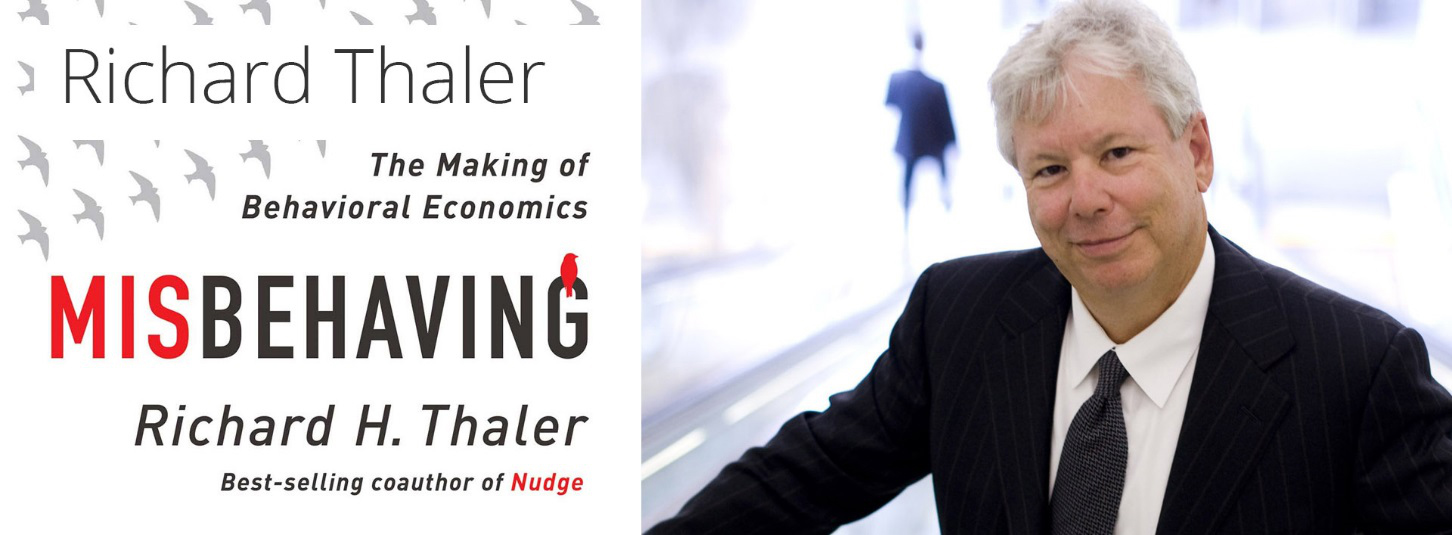
In general, the behavioural economic position is that people are not perfect and do not always make the most rational decisions. The TBS™ recognises this and assists.
Boy, do I wish I had a TBS™ in 2002 when I created Cape Villas.com.
By coincidence at the point of writing (on the 26th April 2018), I have just arrived at section 8 in Thaler’s book ‘Misbehaving: The Making of Behavioral Economics’; where Thaler asks, ‘Could we use behavioural economics to make the world a better place?’ And the answer, in the content of Angel Theory and the TBS™, is ‘hell yeah.’ All improvements to the TBS™ will immediately help our prototype Villa Secrets Network; and in time, the thousands of business that will be created via Grand Networks.
As for making the world a better place, please spare some time to look at the 26 philanthropic and ecological projects that can be created as a consequence of the business network:
www.angeltheory.org/book3-14/ripple-effects-and-elephants-for-paul-g-allen

S-World UCS Hawthorne – Villa Secrets 2017
Below, we see the original 2017 plan.
Continuing from Chapter 9 and the S-World CRM-CC™ which creates sophisticated task planning software, the S-World UCS™ addition is to gamify the tasks. So, for each task completed, it gives a point’s score.
In the Villa Secrets ‘Scenario 7’ plan (Chapter 19), we have allocated significant funding for profit share which gets distributed to those who have accrued the most UCS points.
It’s a simple enough system to program; each task completed, each best STO or mandate secured, and each booking made has a points value. And as staff and management complete their tasks, they gain points. And each day, there is a points winner. And the points winner gets a percentage of profit share.
Created in this way, we can allow for a sales agent to bring in a big booking, or a property networker to land a mandate and receive a huge score on that day. But the next day, everyone starts from scratch. So, on any given day, anyone can win. And that’s important to the game play and will encourage staff to perform simple tasks such as increasing Facebook likes, or writing tweets in their spare time, as each action has small points score.
It also allows management to steer the team in the direction of gaining mandates and adding properties. As whoever adds a property, will see point wins every time that property is seen on the website, and many more points if its booked; and more still if it’s booked and it makes a lot of money.
This not only focuses staff on adding properties, but also on adding properties that will make money and adding them as well as can be done; as in doing so, they increase the chances of being seen and booked, and so more points, prizes, & profit share. (Prizes potentially coming in the form of handbags, glasses, perfume, and after shave from brands like Bulgari; in exchange for adverting space in the Villa Secrets Coffee Table Books from Chapter 18.)
This competition is more about motivating the support staff and management than the frontline sales and mandate staff, as such staff are already motivated with commission and in many cases, will be equity owners in the company itself.
There will be a great looking winner’s page that shows all points won each day and the daily top 3. And from that point, we can create weekly competitions, in both days won and total points, and monthly; and 3 monthly competitors, which will pay our significant bonuses, for winners.
This system turns the S-Web CMS Framework from simple and beautiful to ‘simple, beautiful, fun, and addictive.’ And as a bonus, as well as the motivation of being a daily or weekly winner, is that we create a very observed view point on each staff member on each day. And so, ‘The Hawthorne Effect’ kicks in improving overall performance from all team members.
S-World UCS Hawthorne – Villa Secrets 2018
Now that we understand the basics, let’s examine some of the more recent additions to the system. First, let’s bring back the leader board from the HMRC demonstration…

And let us recall that as it only 11.26 and only 2 and a half hours into the day, and due to their low handicaps the best players are at the bottom of the leader board.
Handicaps
Monica has won the day 42 times this year and has a handicap of zero. Handicaps are needed to enable the weakest or maybe just the newest members of the team to be able to compete and win. Let’s consider the current 2nd placer Mark Gosling. Mark has 20 wins under his belt. But the wins would not be wins if not for his handicap, based on golf, but changed simply to an amount of points given at the start of the day. For example, at 9 am when the day’s game begins, Mark would start with 75,000 points; whereas Monica, with a handicap of zero, starts at zero. And Richard, with a handicap of 8, would start at about 30,000.
As the day goes through, the low handicap players will (on average) collect more points and by the end of the day will win or be there or there about; unless they have a bad day or just bad luck, which happens. In this example, Mark Long is having a bad day.
Financial Reward
The big difference between this game and the game paid by HMRC is that wins see significant financial reward. Before we consider extra bonuses from sales made and mandates won, just the basic prize would be worth a week’s salary; or if on a low salary (maybe an intern, or low-basic sales person), the daily prize could be equal to two weeks salary.
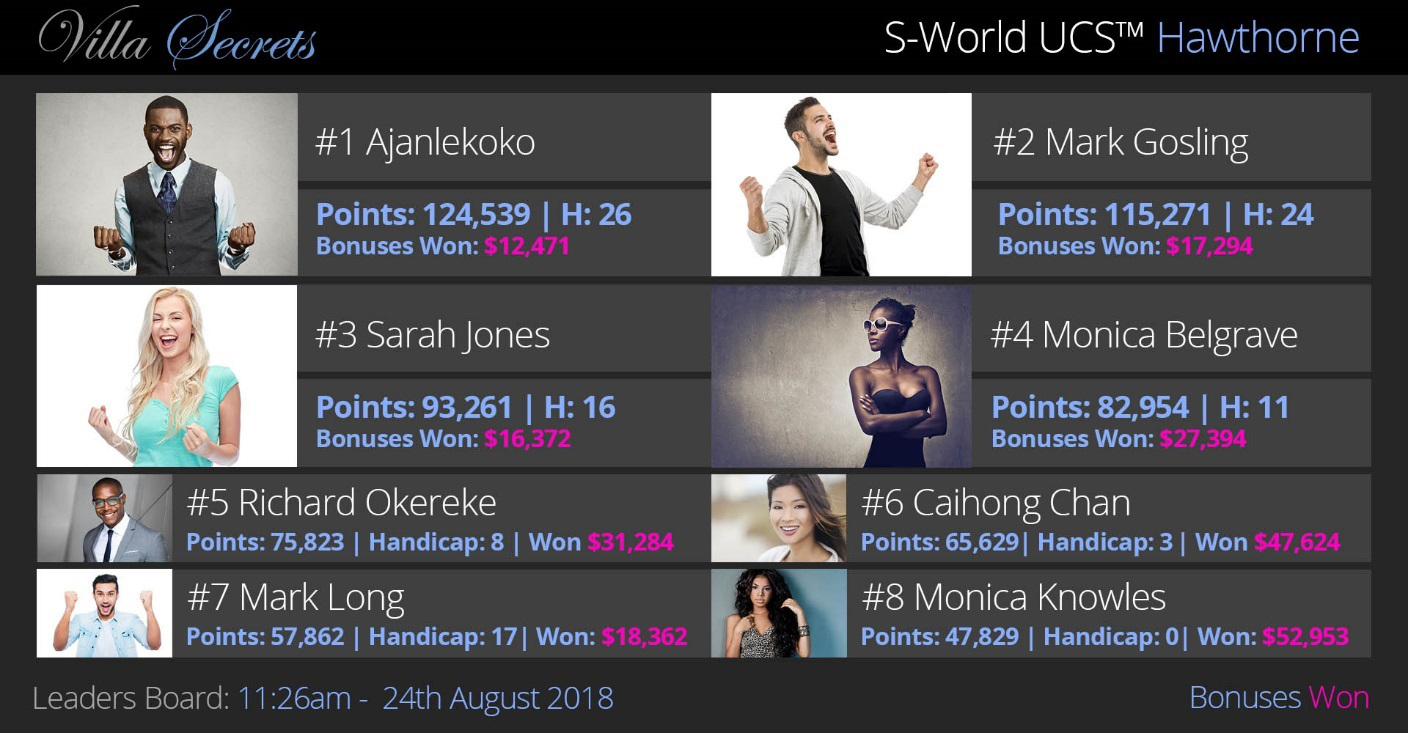
Above, we see that the scoreboard (on the Big TV in the office, on desktop and staff mobiles) changes from handicap and wins to the amount won so far in a year. And note that this is based on Cape Town salaries. if in St Tropez, San Francisco, the Hamptons or any rich location where property sales can be ten times greater, the income from winning could be as much as ten times higher.
Let’s drill down to who is doing what for Villa Secrets Cape Town.
Ajanlekoko – Junior Bookings Agent
Mark Gosling – Concierge Officer, Hospitality Rep & Repeat Bookings Agent
Sarah Jones – Copywriter, Villa Grader & Blogger
Monica Belgrave – Photographer, Cameraman & Video Editor
Richard Okereke – Bookings Agent
Caihong Chan – Mandate Networker and Portfolio Manager
Mark Long – Junior Bookings Agent, S-World Systems Expert and Admin Officer
Monica Knowles – Mandate Networker and Real Estate Sales Agent
Of the above, three would be equity owners and have their own companies within the network and websites that they were in charge of.
In time, the jobs of Mark Gosling, Sarah Jones & Monica Belgrave would be performed by the S-World Film & Concierge company; but at first, all would work under the larger Villa Secrets umbrella.
In 2017, the source of prize funding was the profit share that had been factored into ‘Scenario 7,’ (from The Villa Secretes’ Secret – Chapter 19). However, now I think it would benefit by a percentage of sales agent commission and mandate networker income. Both were expected to make silly money, and sharing 25% of their income with the team via S-World UCS Hawthorne can make the entire team very grateful for every booking made and every mandate won. Each booking’s a winner for all the whole office and the big bell rings to signify each sale.
And whilst the real intricacies of the system should be worked out over time with different variables for different teams, including a control team with no UCS at all, I will provide some starter variables.
So, for instance, each time a sales person or mandate recruiter land a big deal, they will automatically win the day and win half the commission; which ends up with them making 75% of the commission. However, the 25% plus the rest of the day’s value is split between 2nd, 3rd and 4th place. A good villa booking would have a cash value from $25,000 to over $250,000, of which as much as 1% may end up in the prize pool equalling $250 to over $2,500 in prize money. With prizes over $500 seeing as many as 4 different support staff battling it out all evening, doing whatever tasks they can from the SCR-CC options in a bid to win the greater share.
Below, we see the different paths available to personnel to follow and score more points, albeit not all options will be available to all personnel.
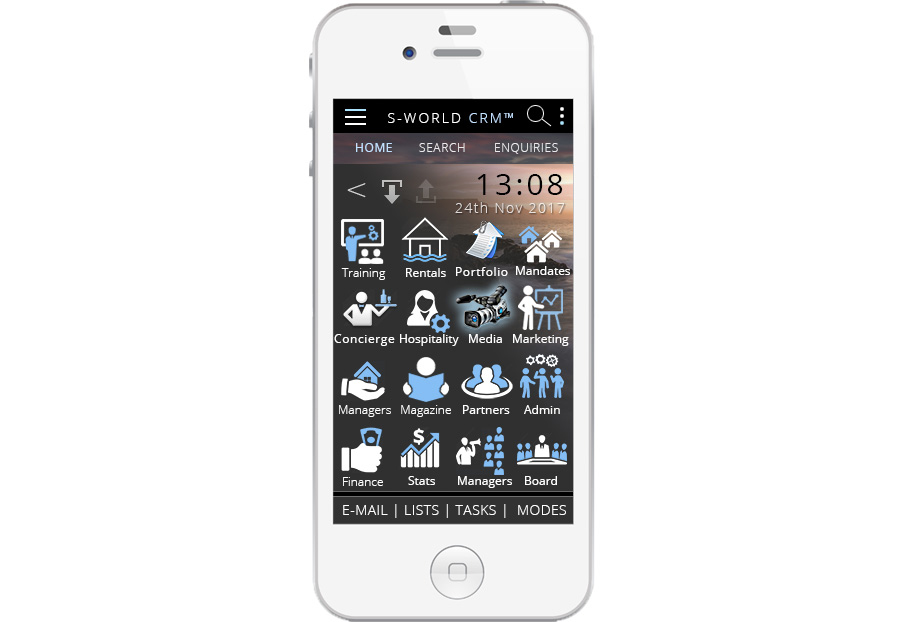
End of Day Winners
Now, let us forward to the end of the day which closes out at 12p.m.
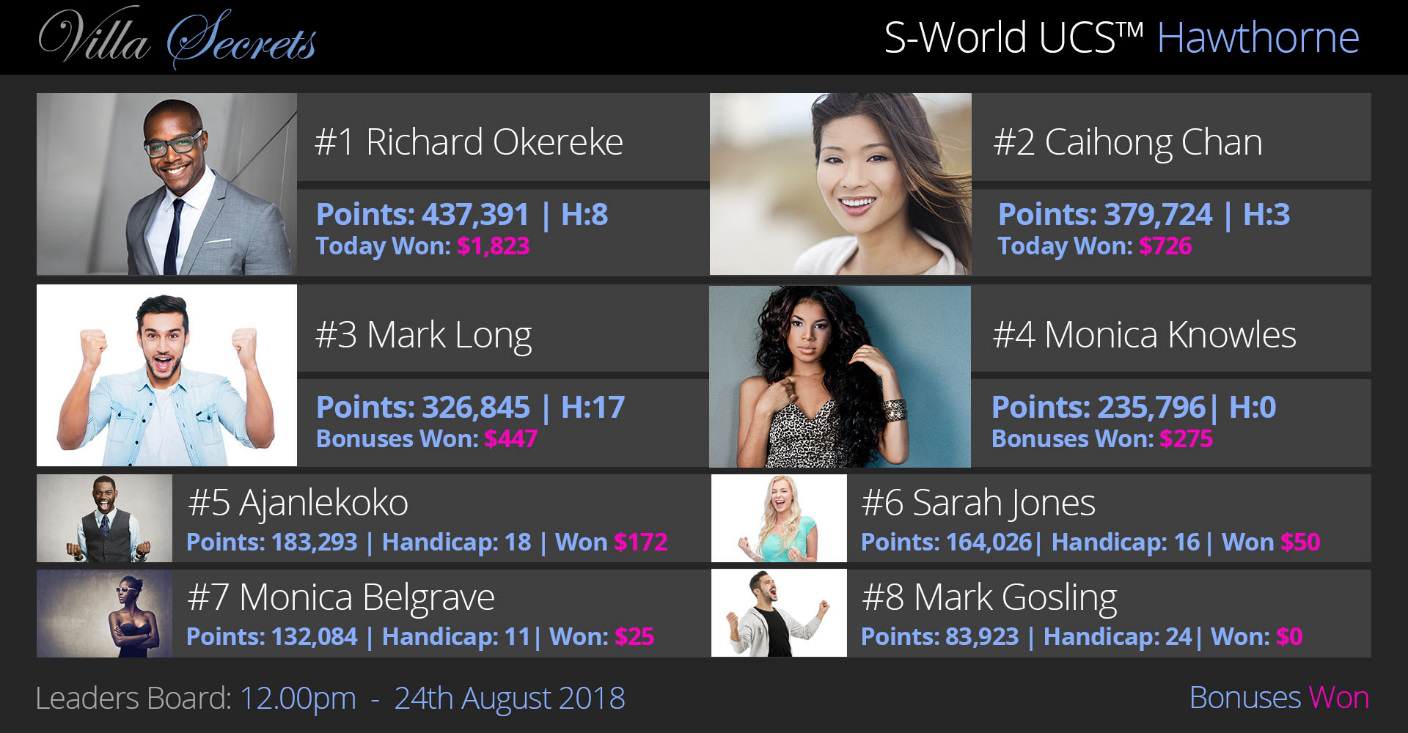
We can see that Richard Okereke has won with 437,391 points rewarding $1,823. Richard won today as a large booking deposit cleared in the bank.
Close on Richard’s heels is Caihong Chan with 379,724 points and $726. The reason for the lower pay out is that Caihong received a bonus for getting a property to an important mandate deal stage, but no money was actually made. Mandates are a ‘reward over time deal,’ in essence once secured, every time the mandated property is rented or sold, the team that secured it receive both financial and points rewards.
Given his score earlier in the day, the day’s big surprise is Mark Long, up from 7th to 3rd. Well actually, it’s not that surprising as a role of Mark’s is the ‘S-World Systems Expert and Admin Officer.’ And Mark likes that the systems have been demonstrated in many simulations, and Mark likes playing the simulations and seeing if he can make deals for his company. So, when 5 o’clock came, with a big bonus payment in the bag and the 3rd place spot worth $447, Mark just slipped into the S-World zone and pumped it until 12 p.m., by which point he had made up the points needed to get 3rd place.
He always does this on big deal days, and whilst some are a little perturbed, all are grateful for the additional business opportunities he creates. And in fairness, he’s actually a little addicted to the game and plays it often, just not in manic win mode, as was witnessed today.
Note that it is people like Mark who regularly play UCS™ simulations who assist in the creation of S-World BES ‘Behavioural Economic Systems’ and help to forge new networks. And when its complete, in S-World UCS Voyager (M-System 13), Mark will be playing an economic time travel game.
In 4th place, we see the team leader (the team leader is usually the lowest handicap player in the team). In this case, Monica Knowles, who has had a real nothing day, no new deals made, and the last thing she was going to do was play S-World UCS™ scenarios all evening to make her score up. In truth she should be last with no points at all if not for the mandates she has secured previously; 10 good mandates and one could almost give up work, as we remember each time any of the properties mandated by Monica are booked, she and the mandates team win points and cash.
In 5th place with 183,293 points and $172 is Ajanlekoko, who received most of his points as he was an assistant to Richard Okereke’s big deal that provided the big prize pot in the first place.
The slacking off algorithm
The last three places see only a token win; $50 for 6th, $25 for 7th, and nothing for last place.
Given that at a certain point in the day, even if like today it’s a bumper pay out, the lowest scoring personnel have a good idea that the game for them is over; and thereafter, work in a typically unenthusiastic way, we need to include a ‘slacking off algorithm.’ The system will monitor the day via the S-World CRM CC ‘Company Controller’ and if it detects a work rate less than 25% of the average work rate then a warning appears. And if ignored, one will receive negative points the following day.
The Joker
In the same vein as ‘the slacking off algorithm,’ in that it is an encouragement for those with low scores to apply effort, the Joker (which is new today 19th June 2018) is a new idea for someone with low points to play their ‘joker card,’ and be boosted to equal points with the top player. As always, only experiments can know the best rules to apply. But, as a starter, I think only 4 cards per year and only one card can be played in one month.
One also needs to consider when they can be played. For now, let’s say 4 p.m., and the card was played when a big booking was made, like today (but we will not show this option in this example). Once played, the current top scorer has equal points and can choose just to accept it and lose half their winnings, or they can play to win in a light way; by simply relaxing at home with new enquiries and live chat calls coming in via their mobile or laptop. An evening spent working on deals, taking new enquiries, and answering live chat will (in most cases) be enough to see of the Joker playing team member pushed into second.
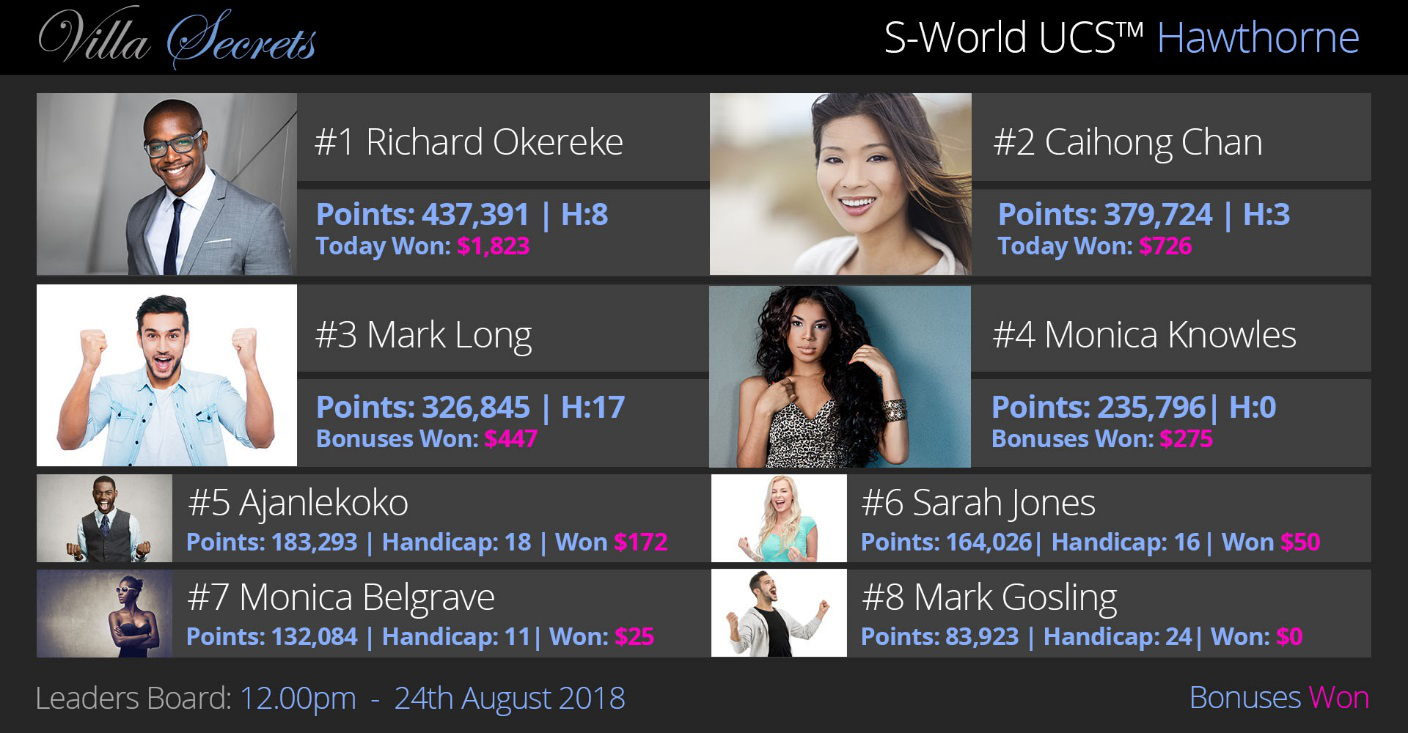
Continuing with the wins description…
In 6th place with 164,026 points, we have Sarah Jones ‘Copywriter, Villa Grader & Blogger.’ Sarah makes most of her points via bookings and enquires on villas she wrote the article on, and it was a slow day.
In 7th place with 132,084 points, we have Monica Belgrave, who had a bad day as the weather was awful; so, 2 planned shoots were cancelled. And whilst she gets points every time she photographs or films a property, just like Sarah, none were booked today. However, if she were a couple of years into working with Villa Secrets, she will have hundreds of income sources.
In last place with 83,923 points is Mark Gosling, who had a bad day, and became the office joke for a while as all observed him lose; which gets us back nicely to the point of the game, so create an observed environment because we know that when people are observed, they work harder.
Lastly, note to self to have pictures reflect the score; so we would need a very sullen picture for Mark on this day.
UCS ™ Recruitment
This point links nicely to recruitment which is another S-World UCS™ quality.
When it comes to recruitment, if one was targeting a job that would pay $1,500 a month basic (remembering we are talking South African salaries), the package would be $750 basic plus whatever UCS™ Hawthorne winnings one made. Where after, 50% of all support staff salaries become part of the prize pool alongside the commission from bookings and mandates. And because of the extra income from the bookings and mandates, even a poor show would make more than the $1,500.
In my opinion and in general, the behavioural science backs this up. Very few people think of themselves as losers, and most have a far higher opinion of themselves than the average would suggest. And so given the opportunity to make $750 and significantly more in prizes; just by beating half the team, especially given that new to the game players start with a high handicap, I can see this system weed out any inherently lazy staff who are only working to pay the rent.
However, in my experience, there is sometimes a 2-month cooling off with personnel; when they can get into a comfort zone and are no longer so enthusiastic or productive. And for sure, in my experience of assigning and monitoring of tasks, without a system like the S-World CRM CC, it is an almost impossible job to get right all the time. And in some cases, just having half your team perform well is enough and is what one settles with.
Not with S-World UCS™ Hawthorne and the CRM CC, which collectively make each day a completion, and some days when big deals are done, there is a big competition going on.
I would say that S-World UCS™ Hawthorne, as presented, would more than double the output made by staff, add to that the systems like the CRM-Nudge-Ai, and one could see greater than double gains. Then add to that S-World VSN™ and S-World UCS™ Simulator and one can see all business that join the network leading each and every market and location it chooses to perform in.
So now, it’s over to Richard H. Thaler, the 2017 Nobel Prize winner. Currently (as of 12th June 2018), Professor Thaler has a giant equity bundle in the bag which, given the scale of Angel Theory – Paradigm Shift, is worth many fortunes.
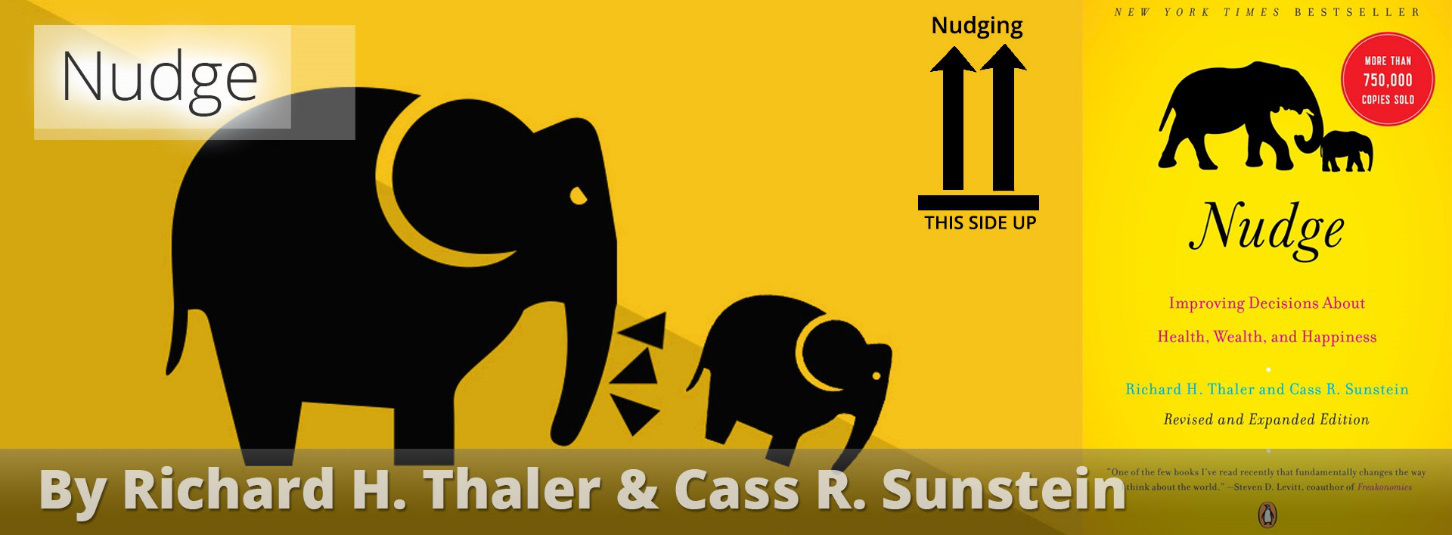
However, other than the www.CapeVillas.com and www.VillaSecrets.com websites, until we get our first pick of Silicon Valley philanthropists assistance in developing the software and grow the network, there’s not a lot of spare cash around.
Fortunately, one thing that Thaler discusses in both ‘Misbehaving’ and ‘Nudge’ is a lack of business that are willing to let them experiment. For this reason, some of the best ‘high value’ behavioral economics comes from game shows such as ‘Deal or No Deal’; which, in itself, is not a very rounding medium, as one adds the variable that all contestants know they are being observed so may make different choices.
The Network plan for Villa Secrets (and other S-World ventures) is on part seen in Chapter 2 – ‘Network Strategy.’ The quick version is that in one location we find a master licensor, usually the leading real estate company who create a ‘Primary Network’; where after, they have 8 websites and make 8 companies. Then keeping 50% of each company, they either reward current staff or recruit new staff to run the 8 business, each staff member owning the other 50% of the business. This is very important as people work harder when they own something; and in an industry with high staff turnover, one gets to keep quality agents as opposed to see them starting a competing business and stealing clients (happens all the time).
The result is 8 different businesses, which would take about a year to found. Where after, the plan is to branch out into compilatory industries and niches to a set of 64 similar business in one prime location by the end of year 2. And running concurrently, I have a list of 300 prime locations where after there are tens of thousands of 2nd and 3rd tear locations; basically any town where real estate is sold for over $1million or more.
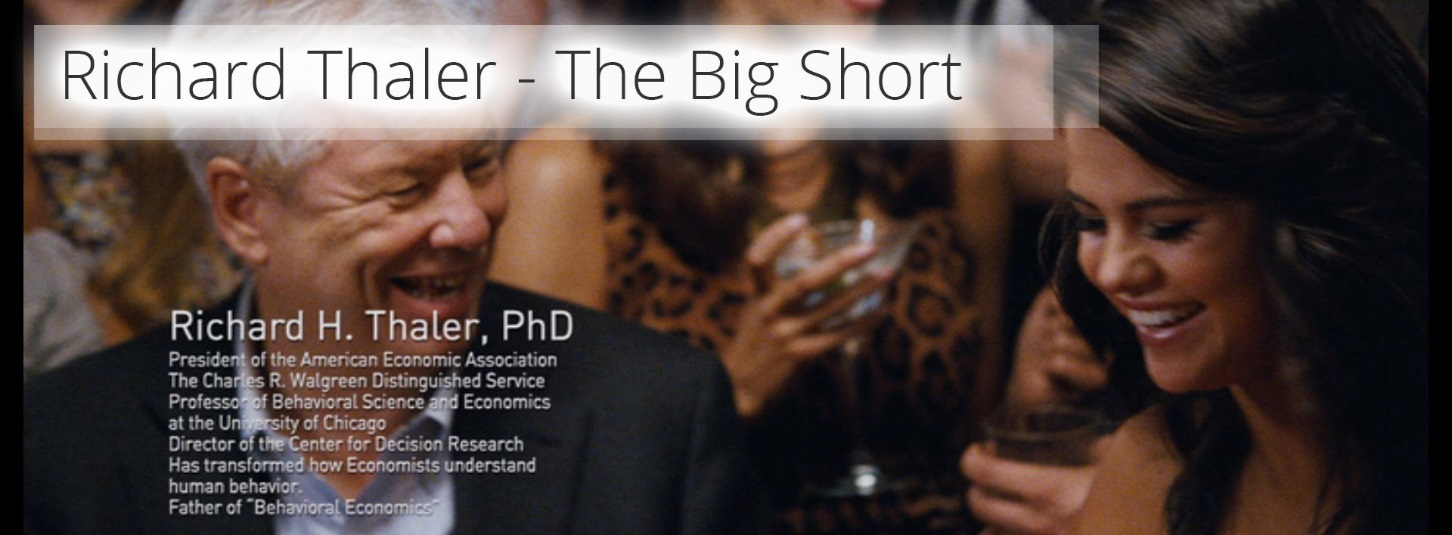
I’m not only happy for Thaler and other behavioral scientists to use this network as an experimental base. I fully believe that that is the best way to develop the system. And with bookings ranging from five thousand dollars to over a million, and properties selling from one million dollars to more than 100 million, the community can really test its ideas in a rich environment.
End of Chapter
More on S-World UCS™
To find more information on S-World UCS™, follow these links :
www.AngelTheory.org/book7/s-world-ucs-simulator-v1 (2018)
www.AngelTheory.org/book/1-3/the-s-world-ucs-m-systems (2017) (requires login)
Network.villasecrets.com/the-secret/ch10/s-world-ucs-tutorial-and-incentivization-game (2017)
Americanbutterfly.org/pt1/the-theory-of-every-business/ch8-s-world-universal-colonization-simulator (2012)
A more in-depth view will be presented in Angel Theory Book 7. And note that Books 2. Part 2. ‘A More Creative Capitalism’ and Book 3. The GDP Game are, in themselves, S-World UCS™ Simulations.
As a picture posits a thousand words, I present the M-Systems architecture. The UCS M-Systems are systems.
10. The ŔÉŚ Equation
11. QuESC ‘The Quantum Economic System Core’
12. S-World UCS™ ‘Universal Colonization Simulator’
13. S-World UCS™ Voyager
14. S-World UCS™ Angel Cities
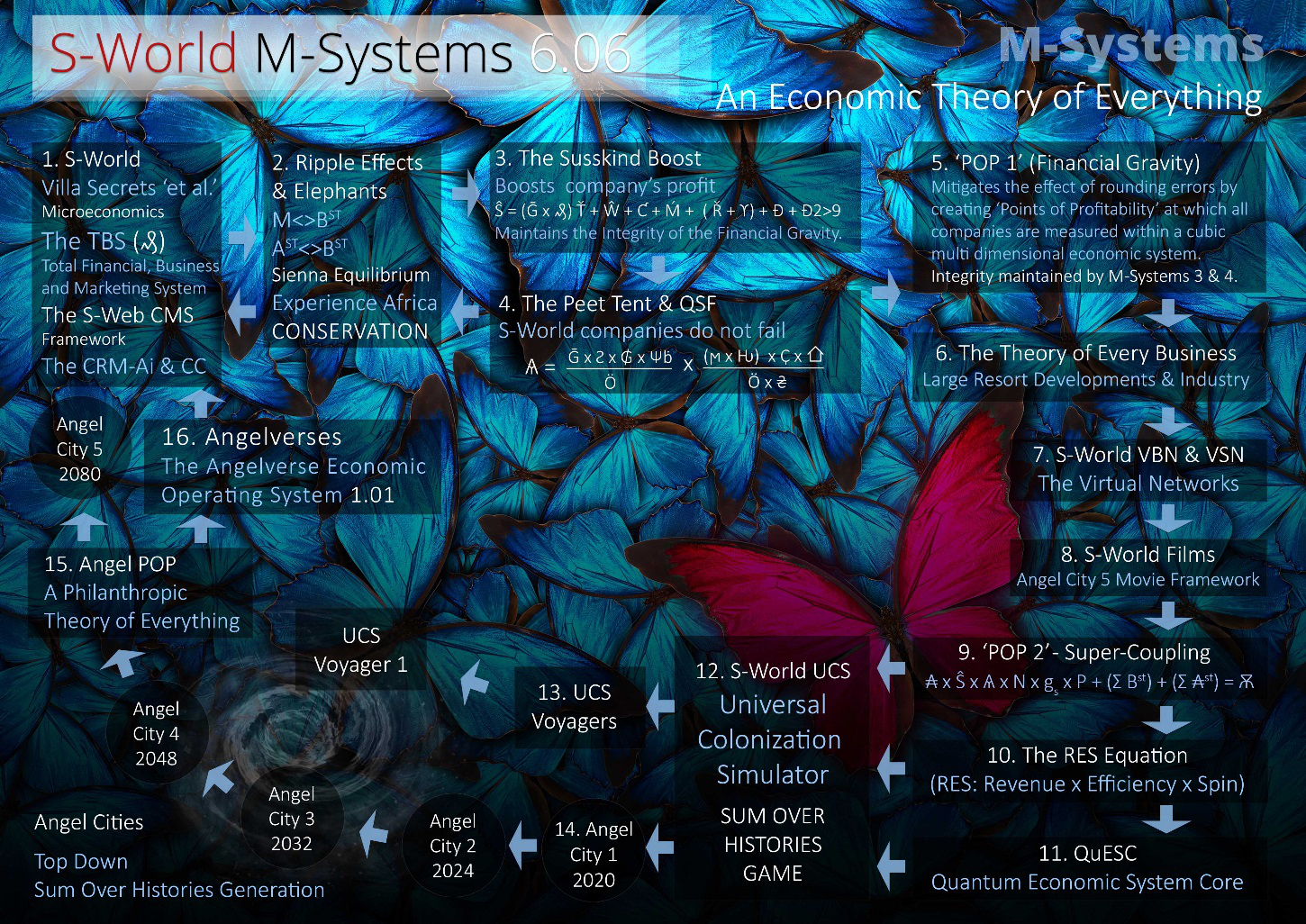
Addendum 1
The S-World UCS ™ M-Systems
Paradigm Shift Book 1. M-Systems
“A Digital Theory of Everything”
By Nick Ray Ball 24th November 2017

PRESENTING
Chapter 3. The S-World UCS M-Systems
“You may not predict what an individual may do, but you can put in motion things that will move the masses in a direction that is desired, thus shaping if not predicting the future.” (Isaac Asimov)
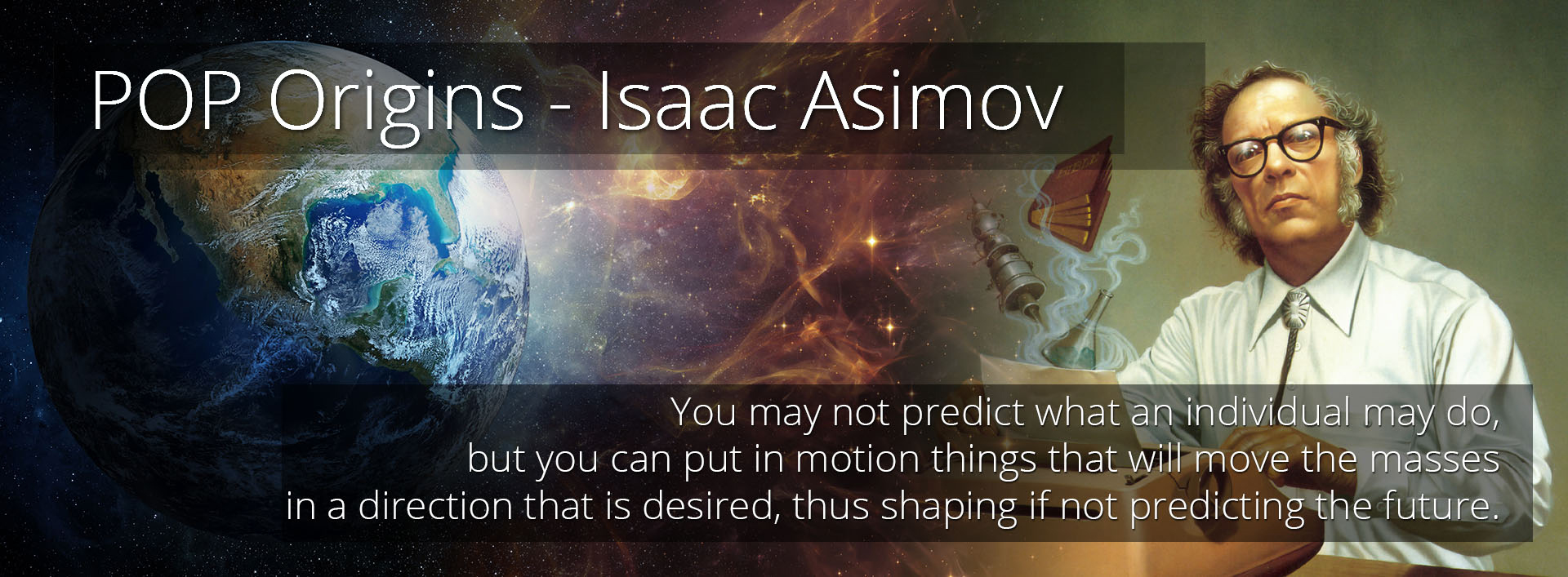
Inspired by: Sienna Skye, Isaac Asimov, President Clinton, Garrett Lisi, Amanda Peet, James Gates, Leonard Susskind, Edward Witten, Stephen Hawking & Albert Einstein.
M-System 10 – The RES Equation – Revenue, Efficiency, Spin (2012 – 2016)
A powerful but simple economic equation that can only be fully effective within a digital economy. Take the initial income of a network (R), measure a company not from its profit alone but also the profit made from its expenses (E), optimize E, and Spin (increase the speed of all spending).
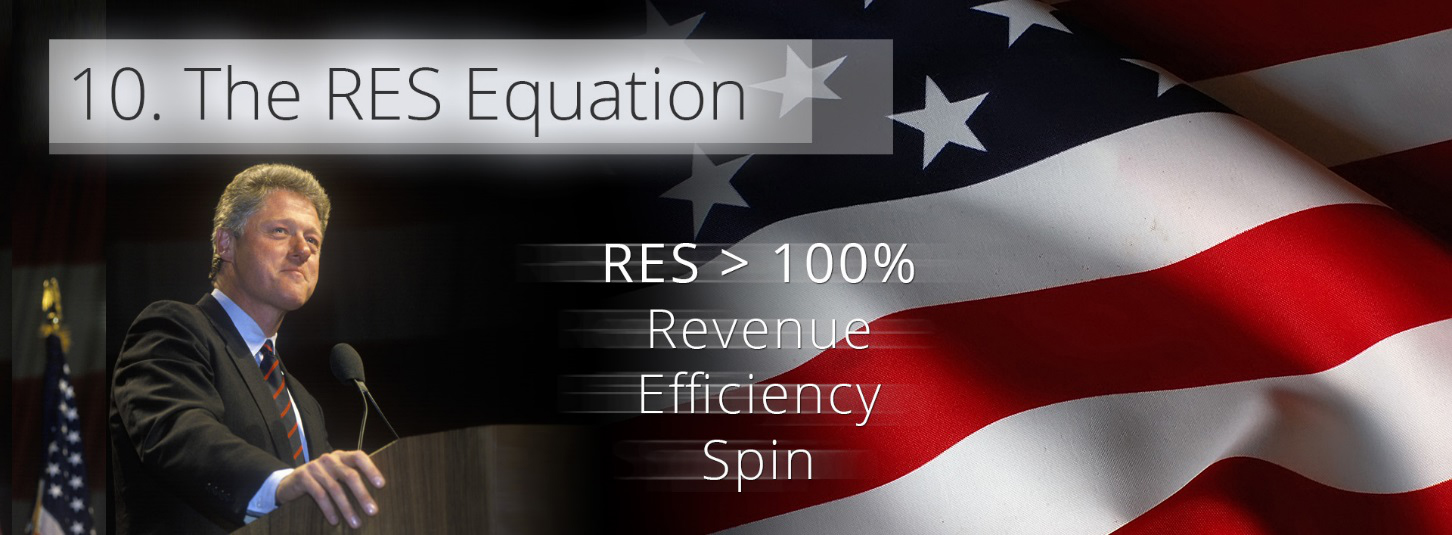
M-System 10 – The RES Equation – Financial Equivalence (2017)
Later, we will talk of S-World UCS MARS Resort 1. Fact or fiction remains to be seen, but on Mars we can implement the RES equation with a 100% Efficiency, which is to say every cent spent is accounted for; where after, we cut tax and spin, creating a supercharged economy unimaginable on earth. We call this ‘Financial Equivalence.’ Our inspiration: ‘the law of conservation of energy.’

M-System 11 – QuESC (The Quantum Economic System Core) (2012 – 2016)
The heart of the M-System’s design is founded on the notion by Hawking that ‘People are like Atoms,’ QuESC entangles us ‘the people’ with powerful predictive and logistic software within a circular butterfly effect, continually experimenting and improving upon all S-World systems.
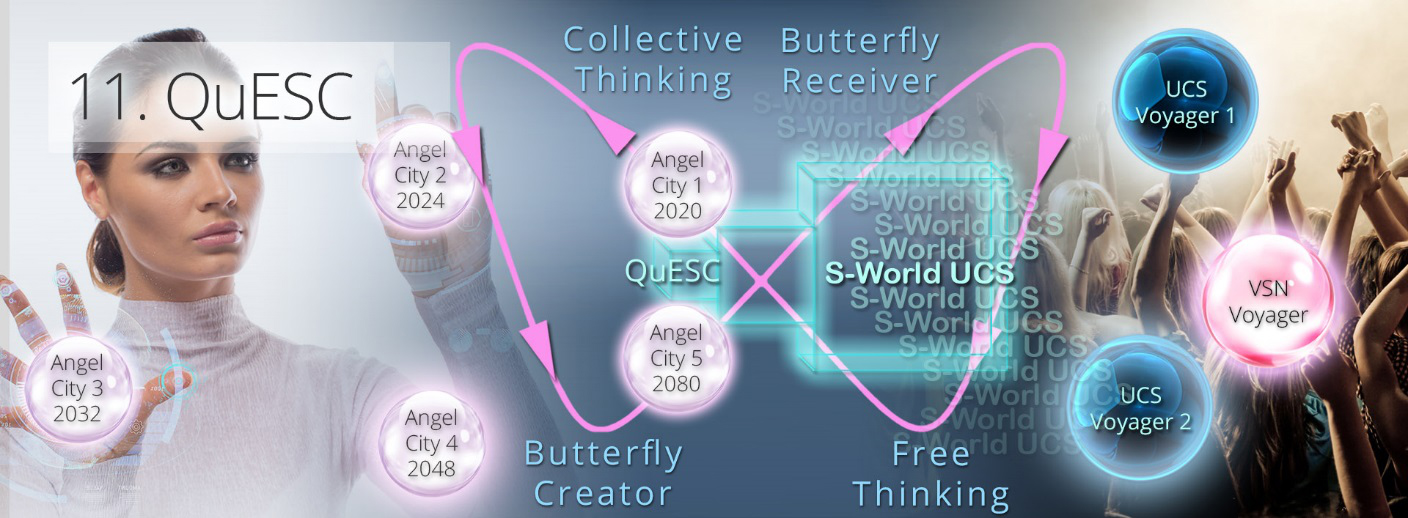
M-System 12a – S-World UCS & Villa Mogul (2003 – 2012)
Originally imagined in 2003 as ‘Villa Mogul,’ the idea to create a management simulation game like Railway Tycoon. The ‘hook’ being that the game was based on a real business. By September 2012, it had developed into ‘TTOEB’ Chapter 8: S-World UCS – Universal Colonization Simulator.

M-System 12b – S-World UCS (September 2012 to 2017) (Connects all systems)
S-World UCS is a design for an MMO game that shows how to make a business and economic empire so rich, one could invest in super projects such as ‘African Rain’ or ‘Universal Colonization.’ The game teaches, simulates, and shines a light on the S-World Network’s future ambitions.

The Quantum M-Systems 13 and 14
Now, we arrive at arguably the main event. The S-World UCS quantum systems that create first an economic time machine and then logistical anchors into the future; from which we desire to shape the world in a direction that is desired, via simulation and then implementation, to create a better future for our children and children’s children.
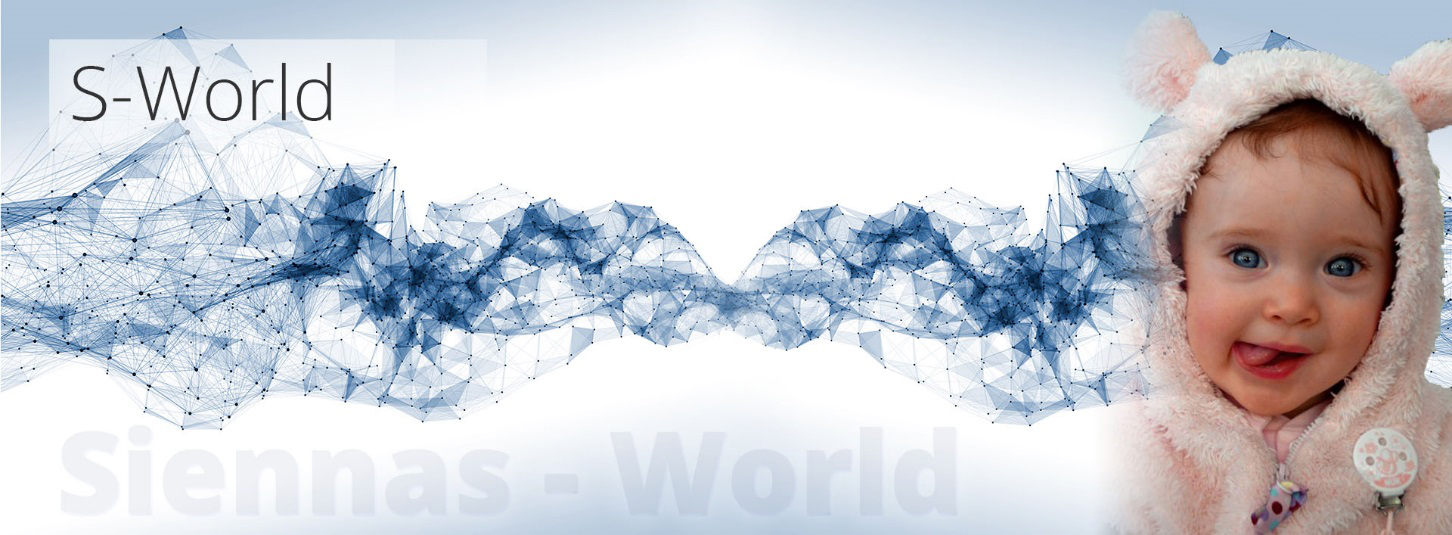
In the now familiar system design below, we can (at the bottom of the graphic) see the quantum systems flying out of M-System 12. S-World UCS, scooping up Angel POP and the Angelverses on the way, delivering them full circle back to M-System 1. And as before, the rodeo starts again, but this time with greater momentum.
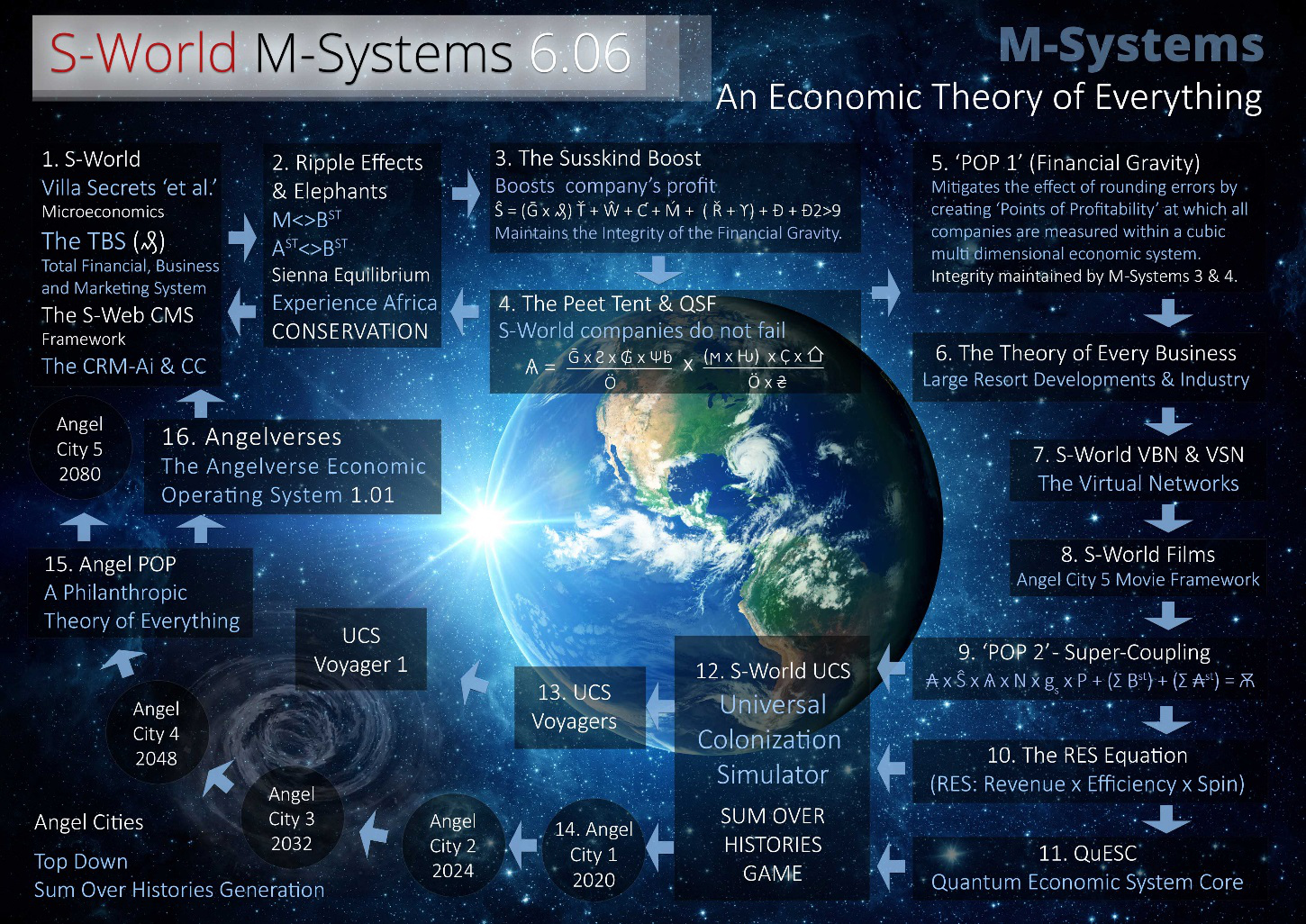
M-System 13 – Eureka!!! – S-World UCS Voyagers (September 2012)
The Eureka Moment arrived courtesy of Garrett Lisi’s ‘A Theory of Everything.’ In which Lisi presents his quantum coral analogy where “each individual was in many other locations experiencing them as separate individuals,” and the quantum mechanics mantra:
“Everything That Can Happen Does.”
This revelation arrived in the middle of writing the final American Butterfly ‘Theory of Every Business’ chapter ‘S-World UCS,’ soon after writing the S-World Virtual & Business Network chapter, in which the game sat within the virtual framework and had become entangled and indistinguishable from the conceptualised business network.
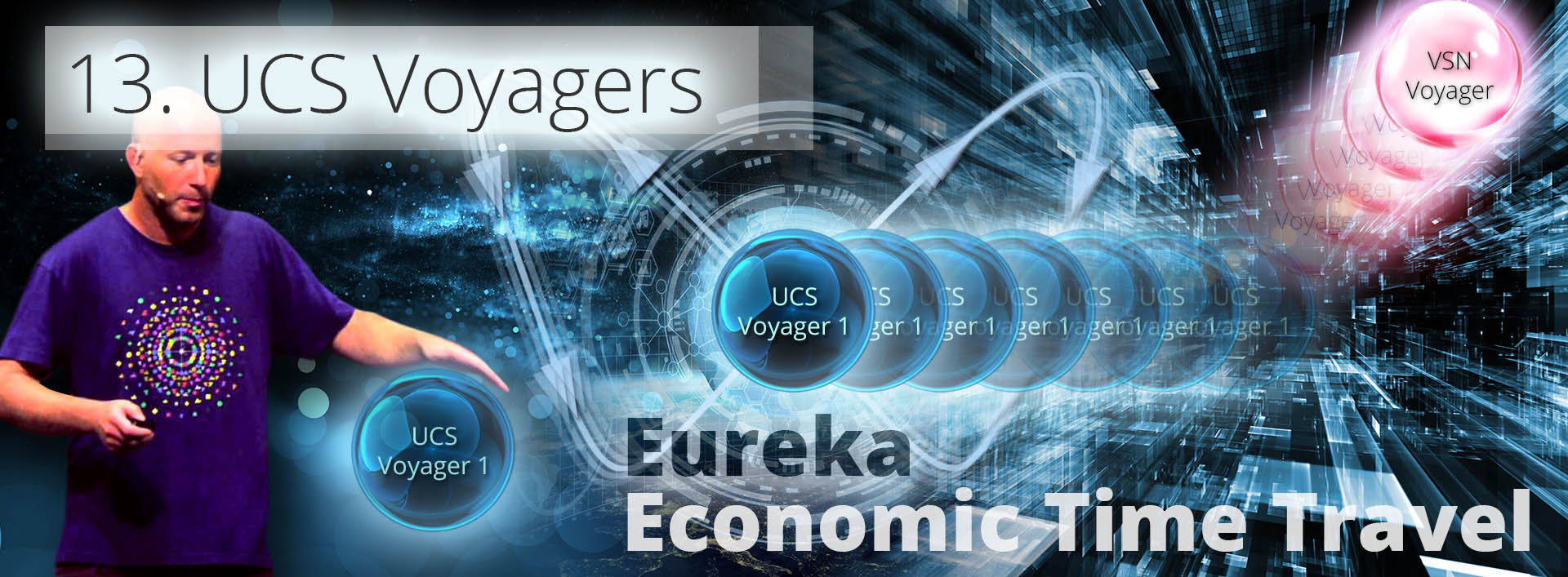
This consideration becoming the tipping point where a simulated game and business software became a form of economic time travel.
The consideration was that we would create a copy of the S-World UCS Network called ‘UCS Voyager’ and send it forwards in time at a speed twice our own. So that in 6 months of our time, the simulation would be a year ahead. And within, business owners, managers, staff, and gamers alike could conduct their own business simulations. Then, from all the possible outcomes choose which actions from the simulations to follow back in real time.
Businesses follow the wins, avoid the losses, and replay opportunities that showed potential in Voyagers 2, 3, 4…

What if you could look to the future and see millions of eventualities?
What if you could use this information to assist you today?
Welcome to S-World UCS
Welcome to your future
M-System 14 – Eureka2 – S-World UCS Angel Cities (2012 – 2017)

Angel Cities are 5 future simulations of the network from 2020 to 2080; first created as logistical support for UCS Voyagers, but have since become the key ingredient, subject of the movie framework, and the ‘why’ behind the entire project. In terms of M-theory and its component quantum mechanics, we respect Professor Richard Feynman’s alternative histories (sum over histories), which tells us that no unobserved system has a definite past or future.
“Quantum physics tells us that no matter how thorough our observations of the present, the (unobserved) past, like the future, is indefinite and exists only as a spectrum of possibilities.”
From ‘The Grand Design’ by Professors Stephen Hawking & Leonard Mlodinow
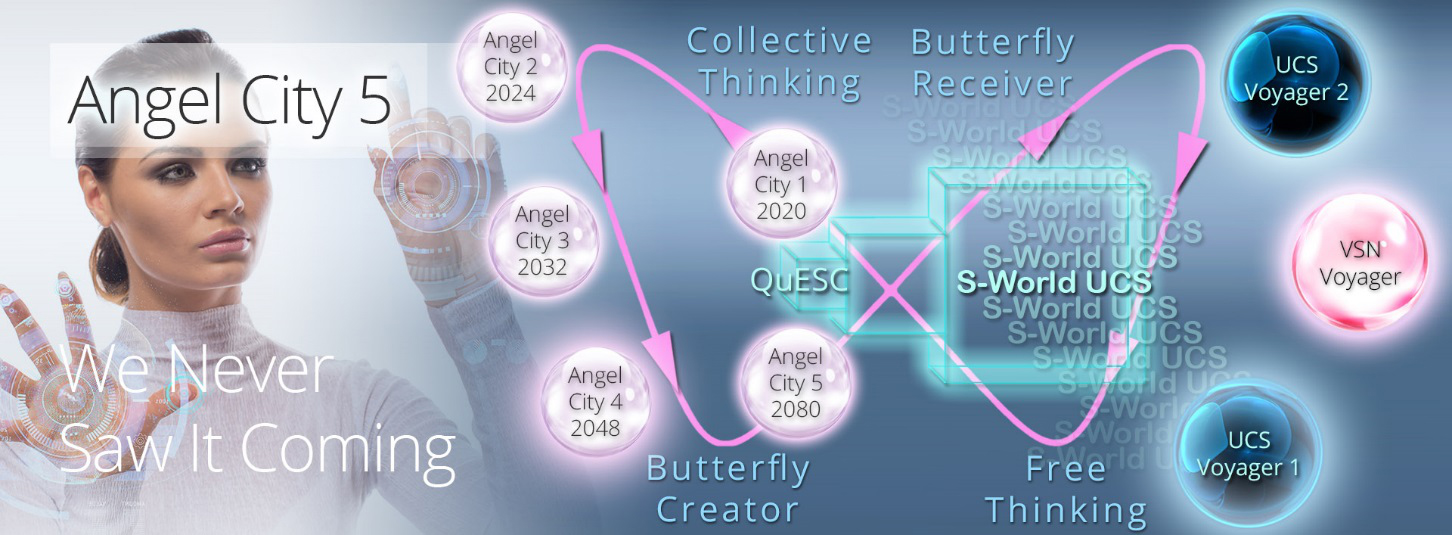
Shaping the Future
Set in the years 2048 and 2080, Angel Cities 4 and 5 are the nerve centre for the S-World network’s long-term ambitions, described as a set of ‘super projects.’ In this simulation, we work within the M-Systems framework to plan the best earth we can logistically create. And once the blueprint is set, we create paths back through Angel Cities 3, 2 and 1 so that each company, development, wonder, and ‘special project’ that we wish to exist in 2048 and later 2080 has a definite history back from the future to our time.
By planning our future in intricate detail and working in waves of probability, ripple & butterfly effects back through the future Angel Cities, we can control our destiny.
Angel City 5 (2080)
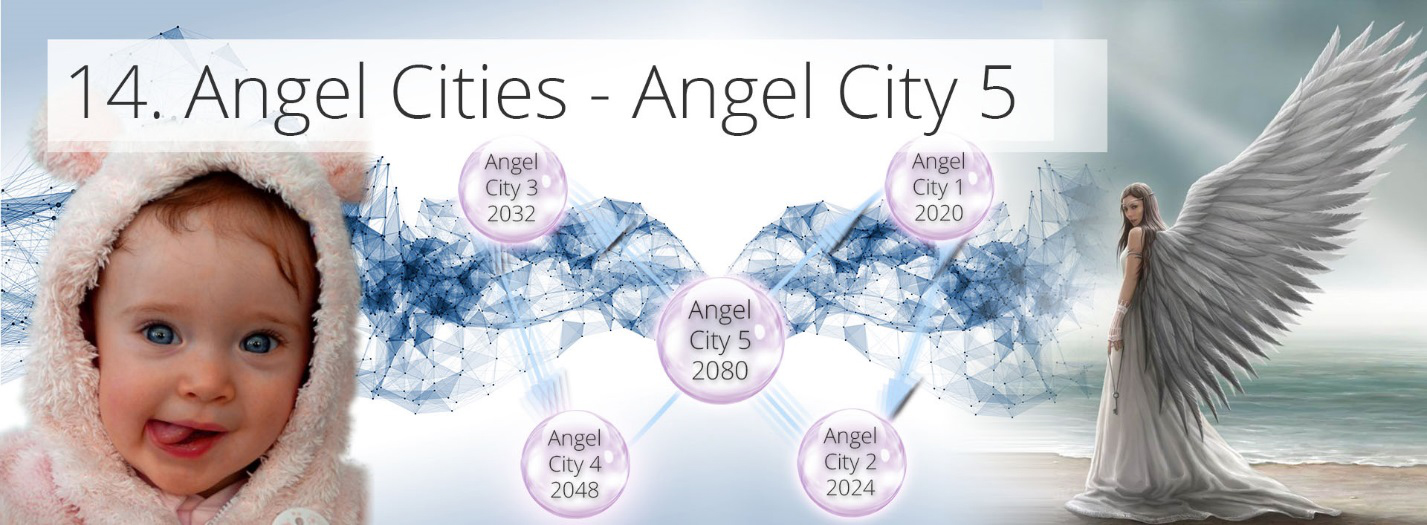
Angel City 5 is the last of the founding S-World Angel Cities set in 2080. Above, we see my darling daughter Sienna as herself and as an angel guiding us towards a better future, in keeping with the S-World mantra by professor Isaac Asimov…
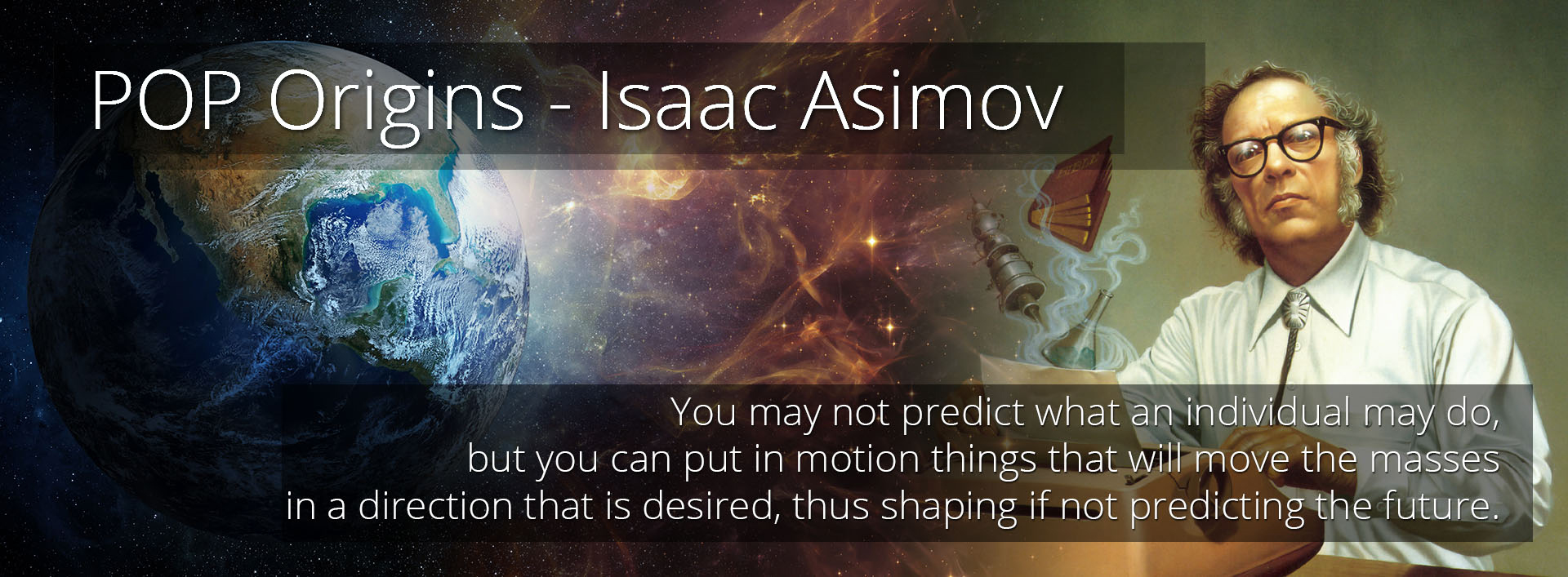
“You may not predict what an individual may do, but you can put in motion things that will move the masses in a direction that is desired, thus shaping if not predicting the future.”

This future <> past relationship is in a constant superflux; but one thing is constant, our ambition, the set of ‘super projects’ that are to be achieved. In Game Theory and military strategy, they call it ‘Commander’s Intent’ (but instead of ‘take that hill, its ‘make them projects’), as commanders know that the best laid plans can quickly fall apart in battle. We must allow for every eventuality when creating the strings that lead to the creation of our ‘special projects.’
However, once enough strings and ripples have congregated, it gets easier. For example, the first of the 16 Super Projects: ‘Experience Africa’ is underway and has become entangled as Angel City 1.
Originally, this chapter led to a list of 16 projects I wished to be created. But since, I have created a chapter on how we can create these projects and more as a consequence of creating grand networks in locations of abject poverty.
See: Ripple Effects and Elephants for Paul G Allen



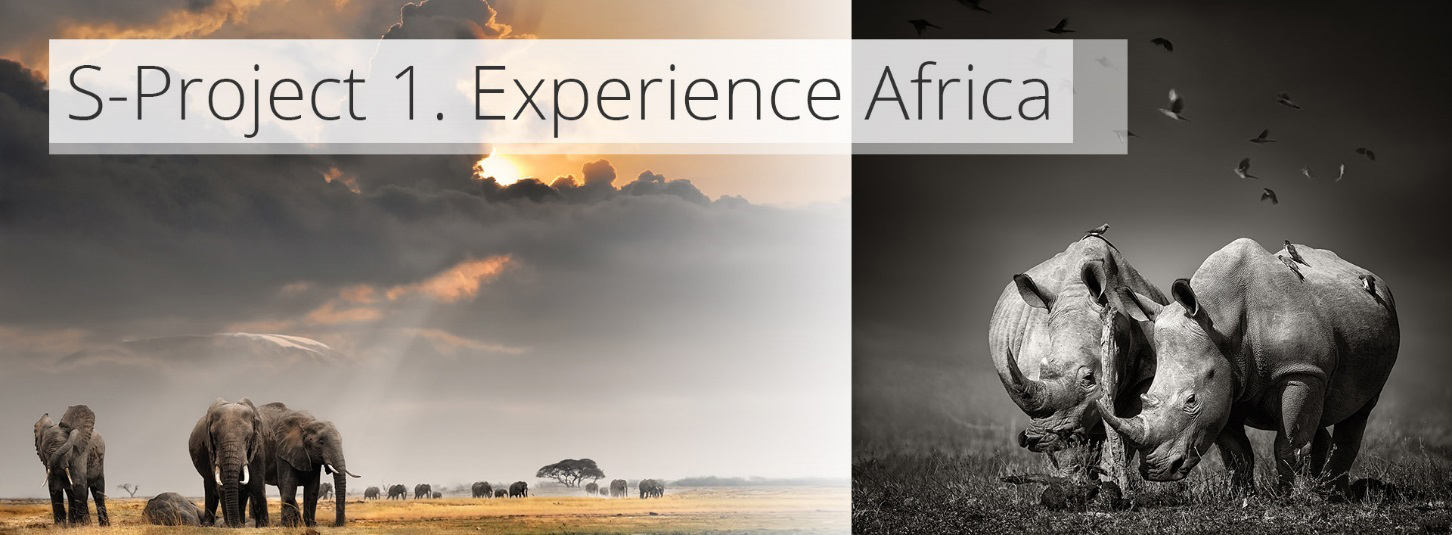
www.angeltheory.org/book3-14/ripple-effects-and-elephants-for-paul-g-allen




















